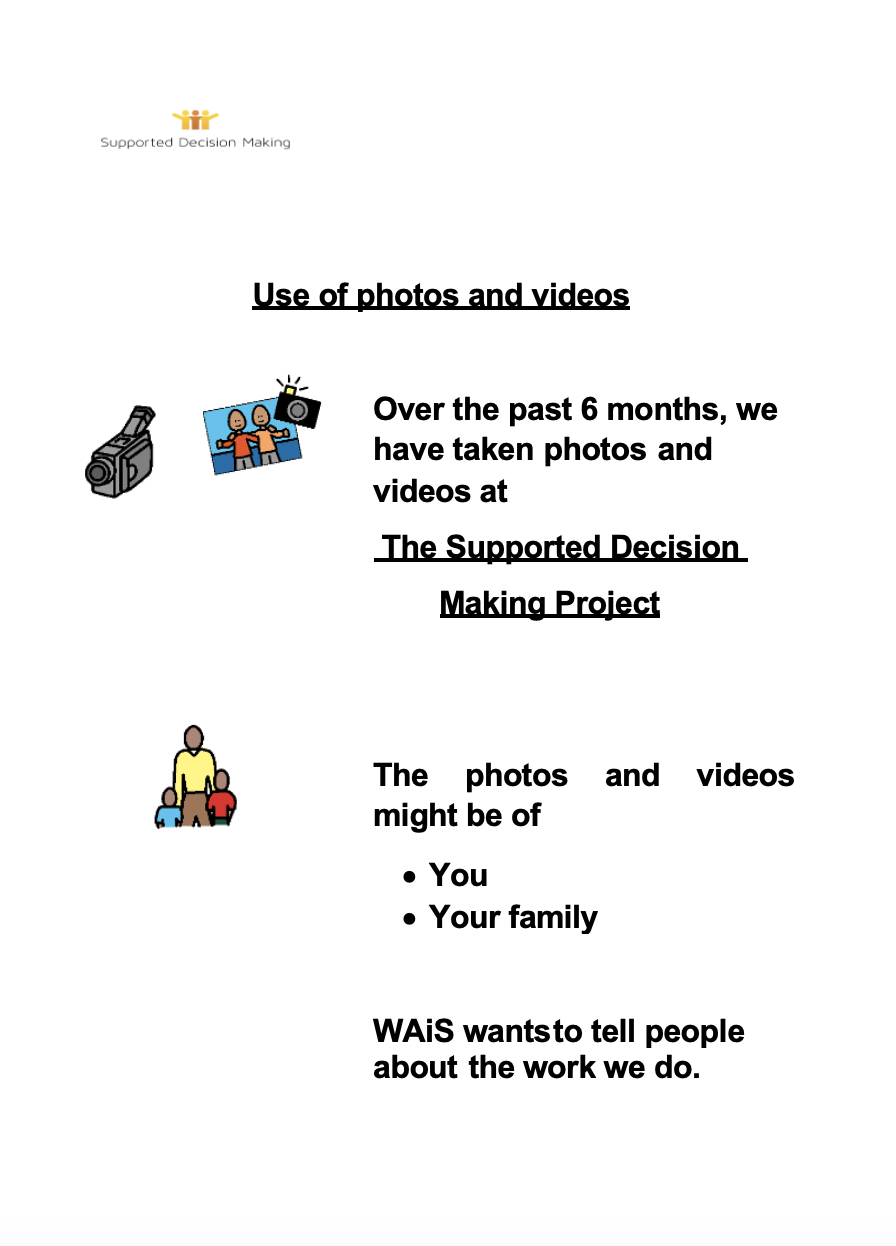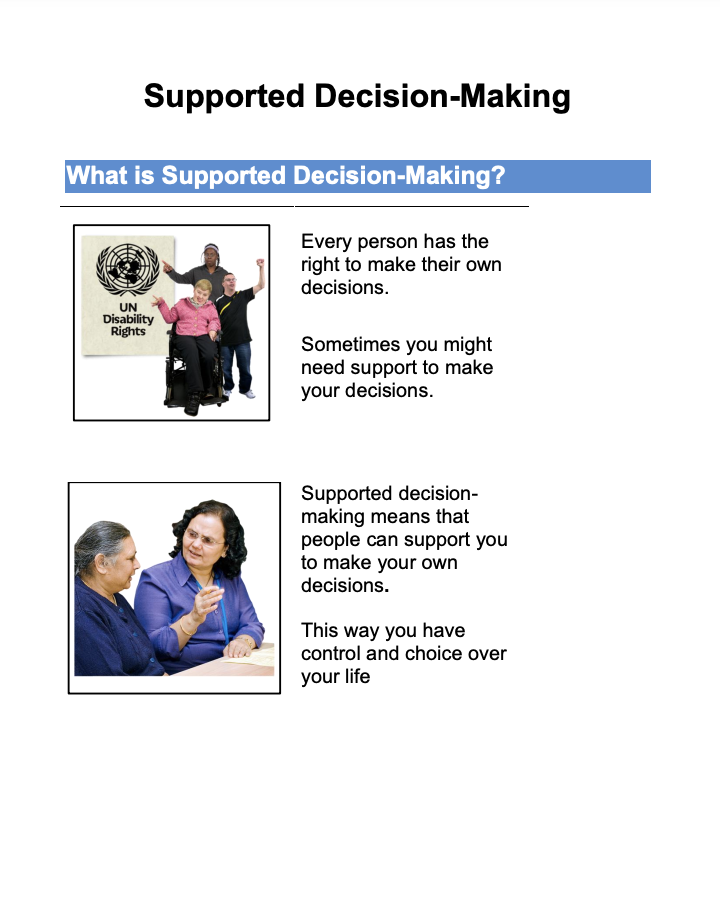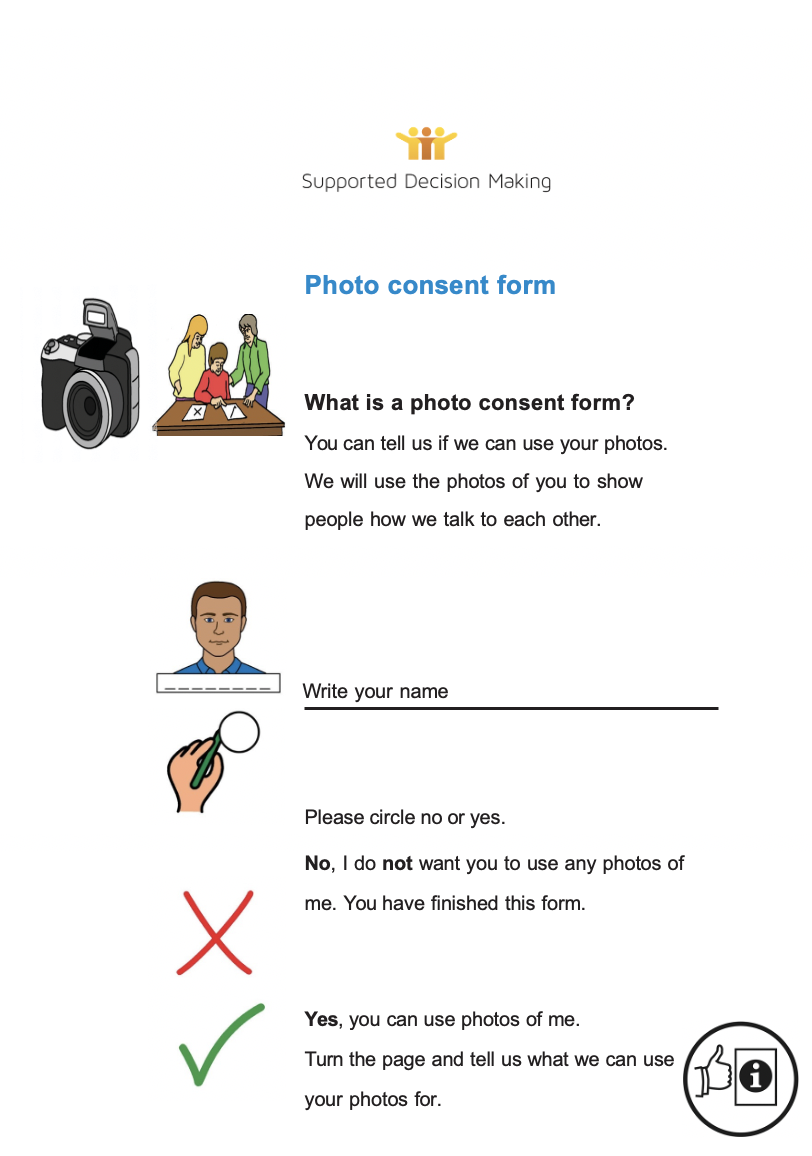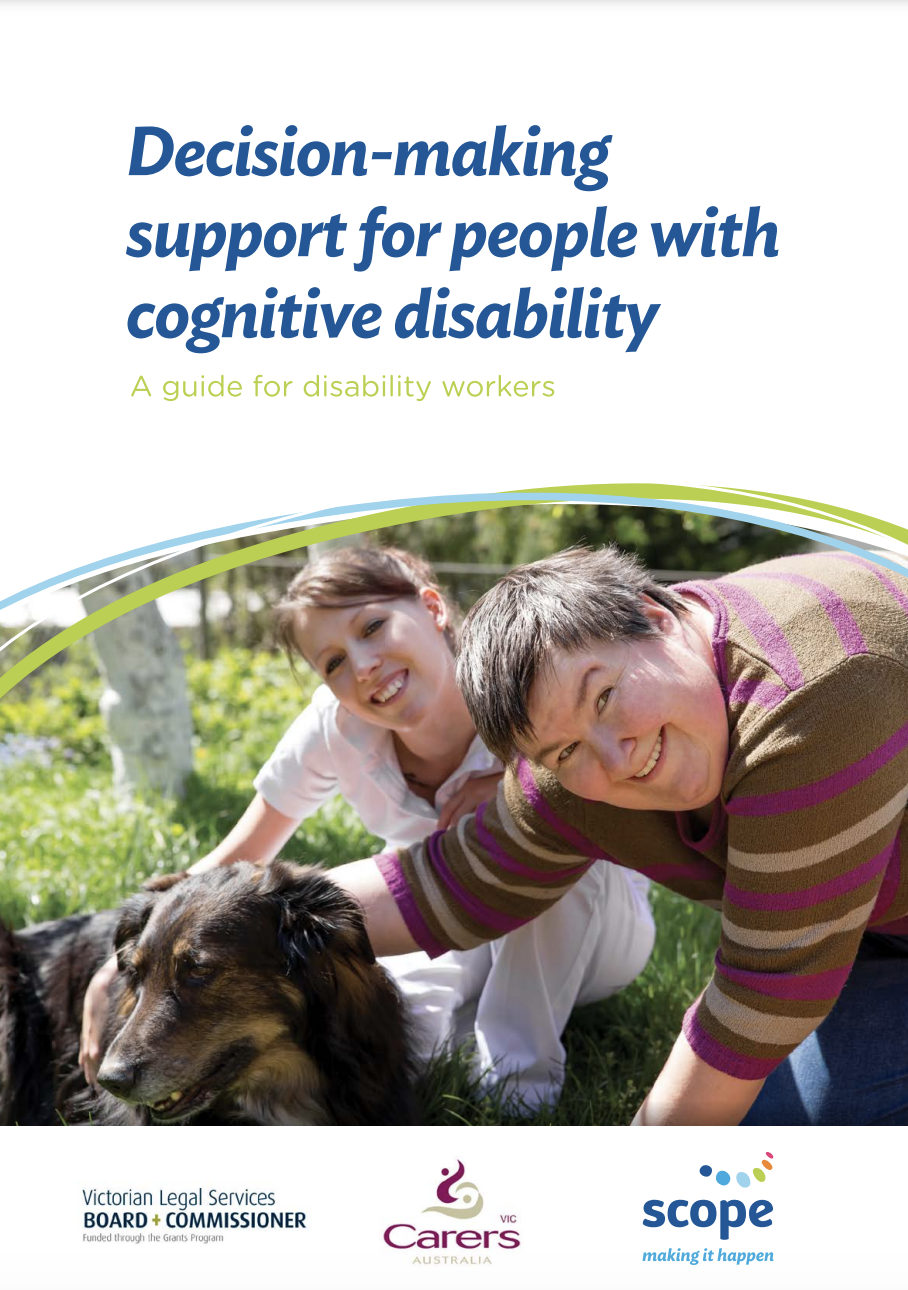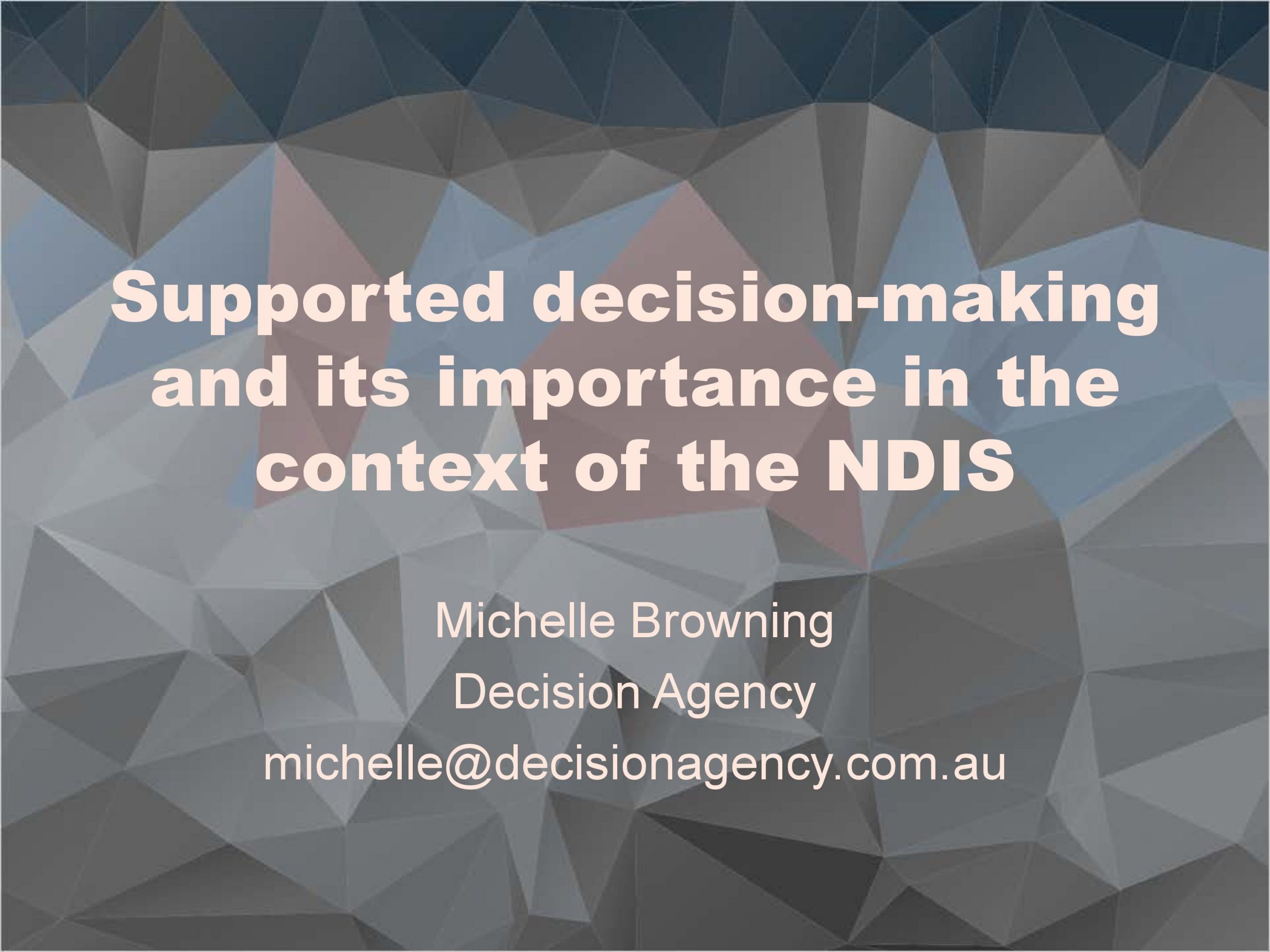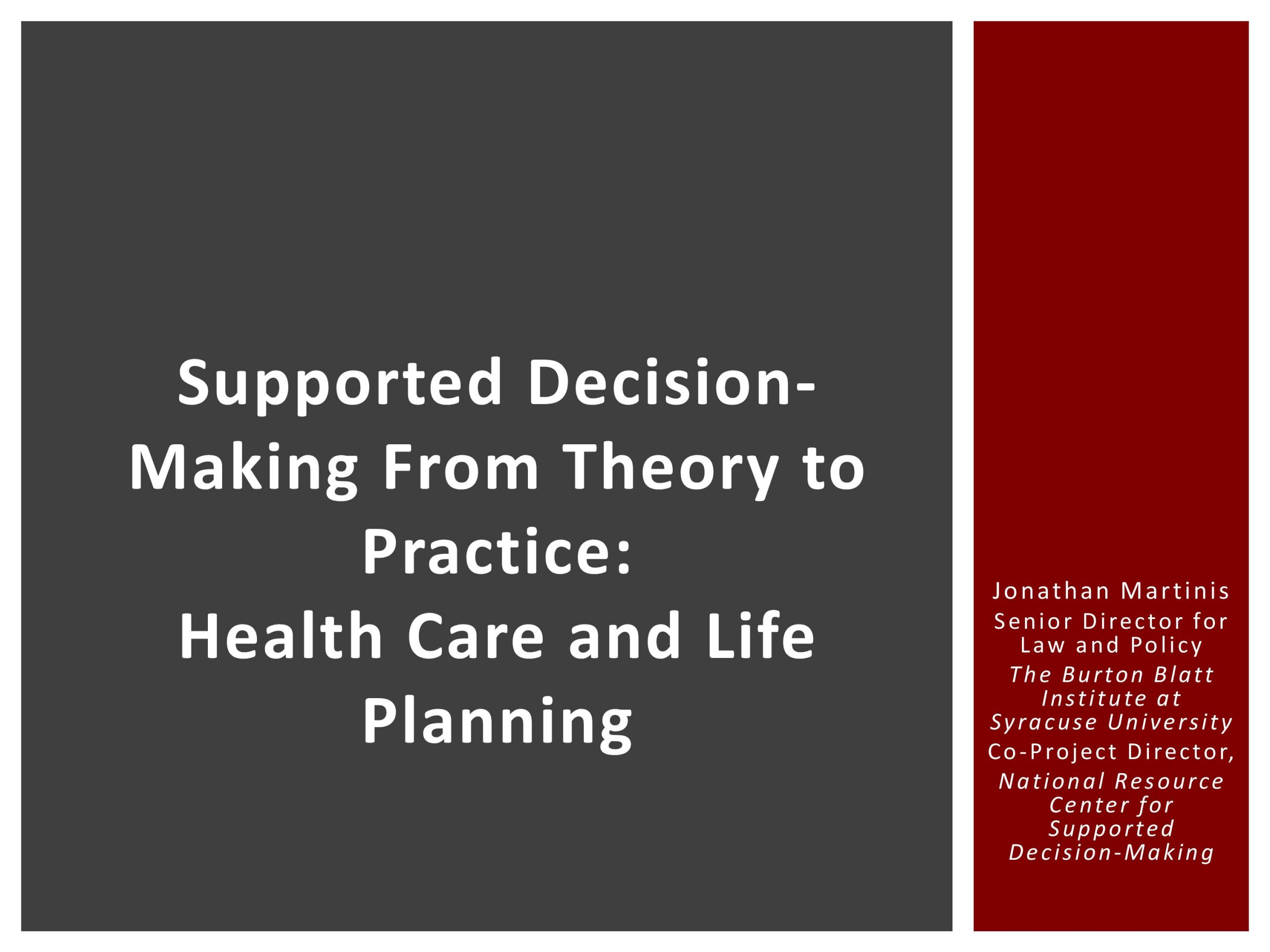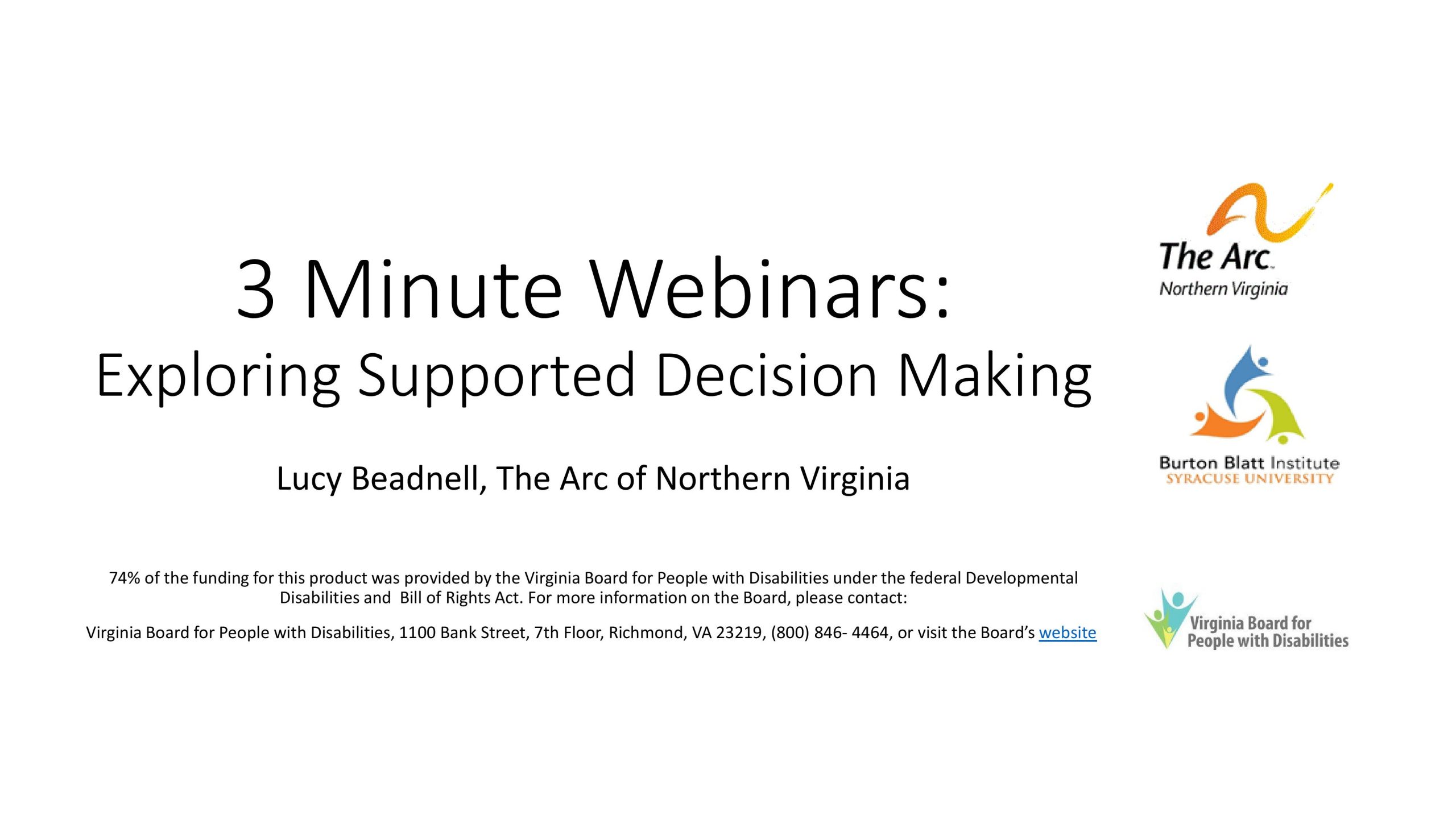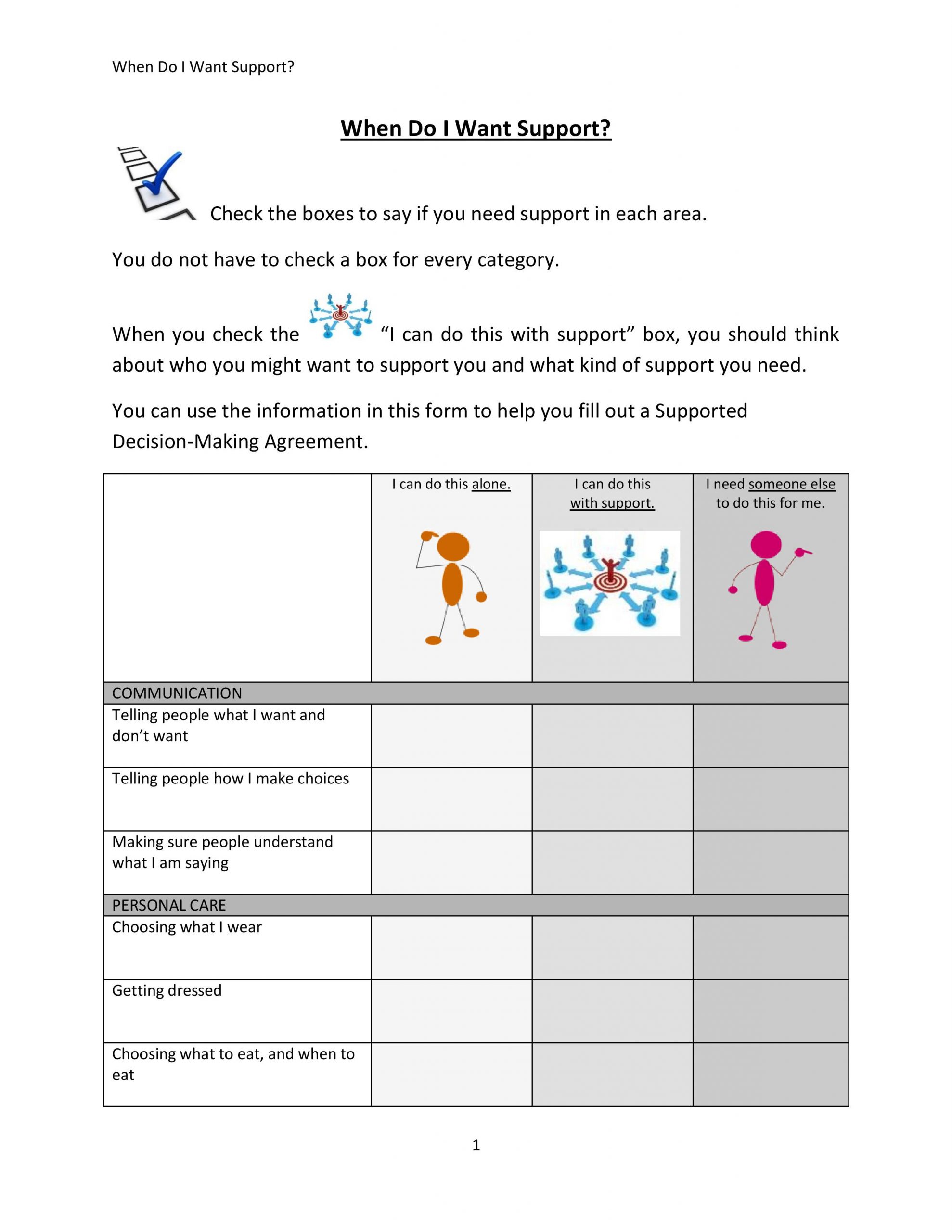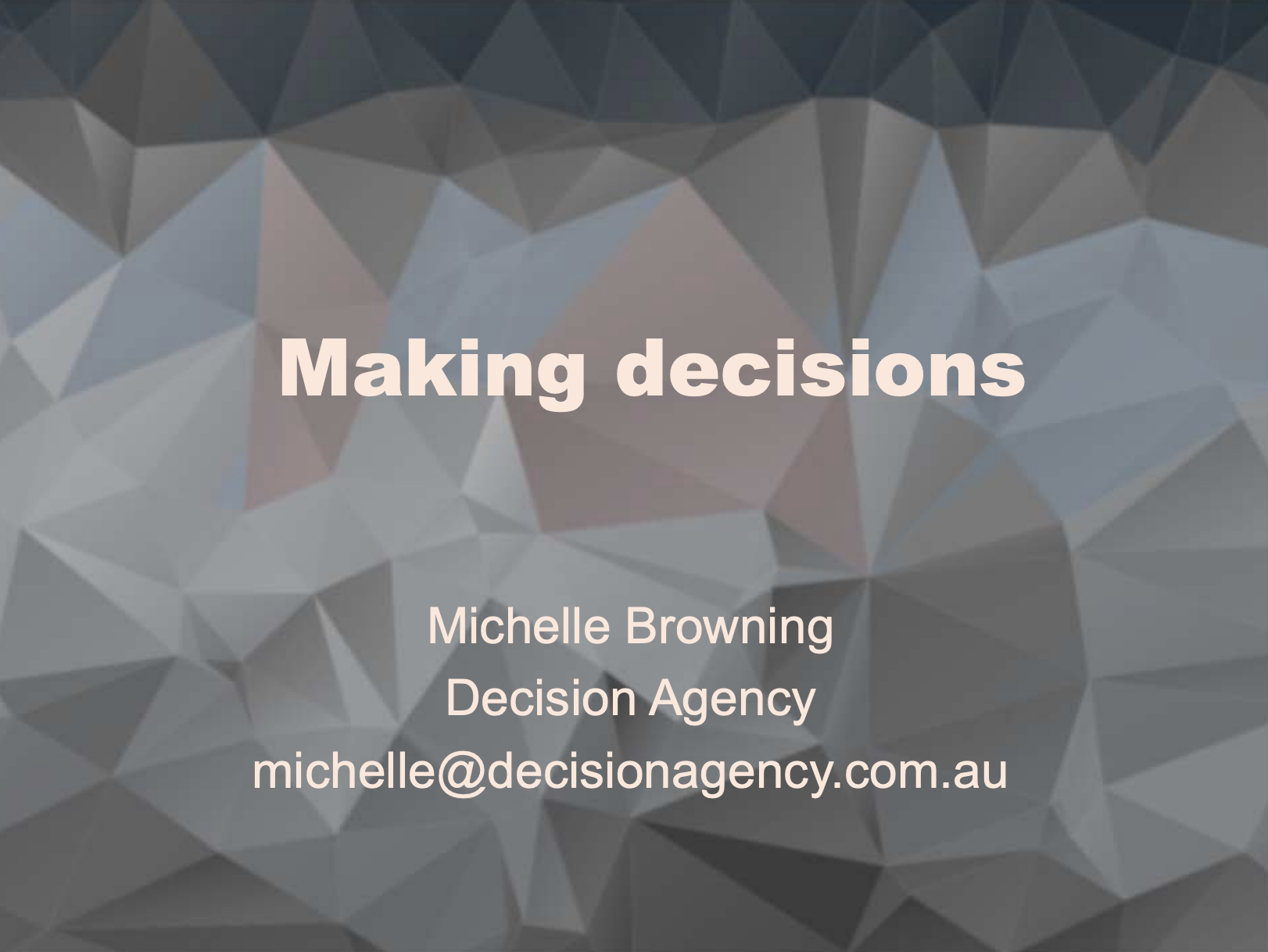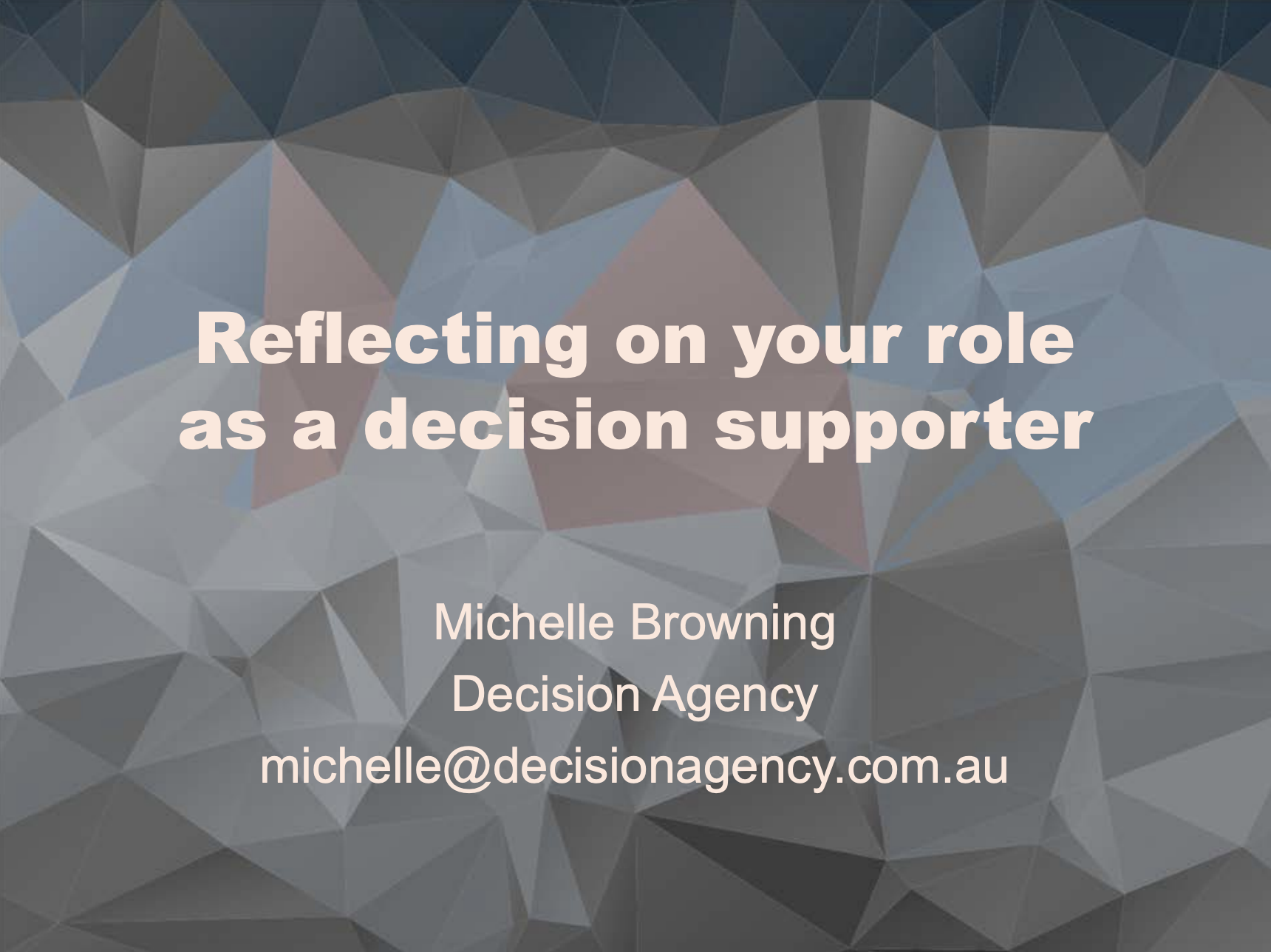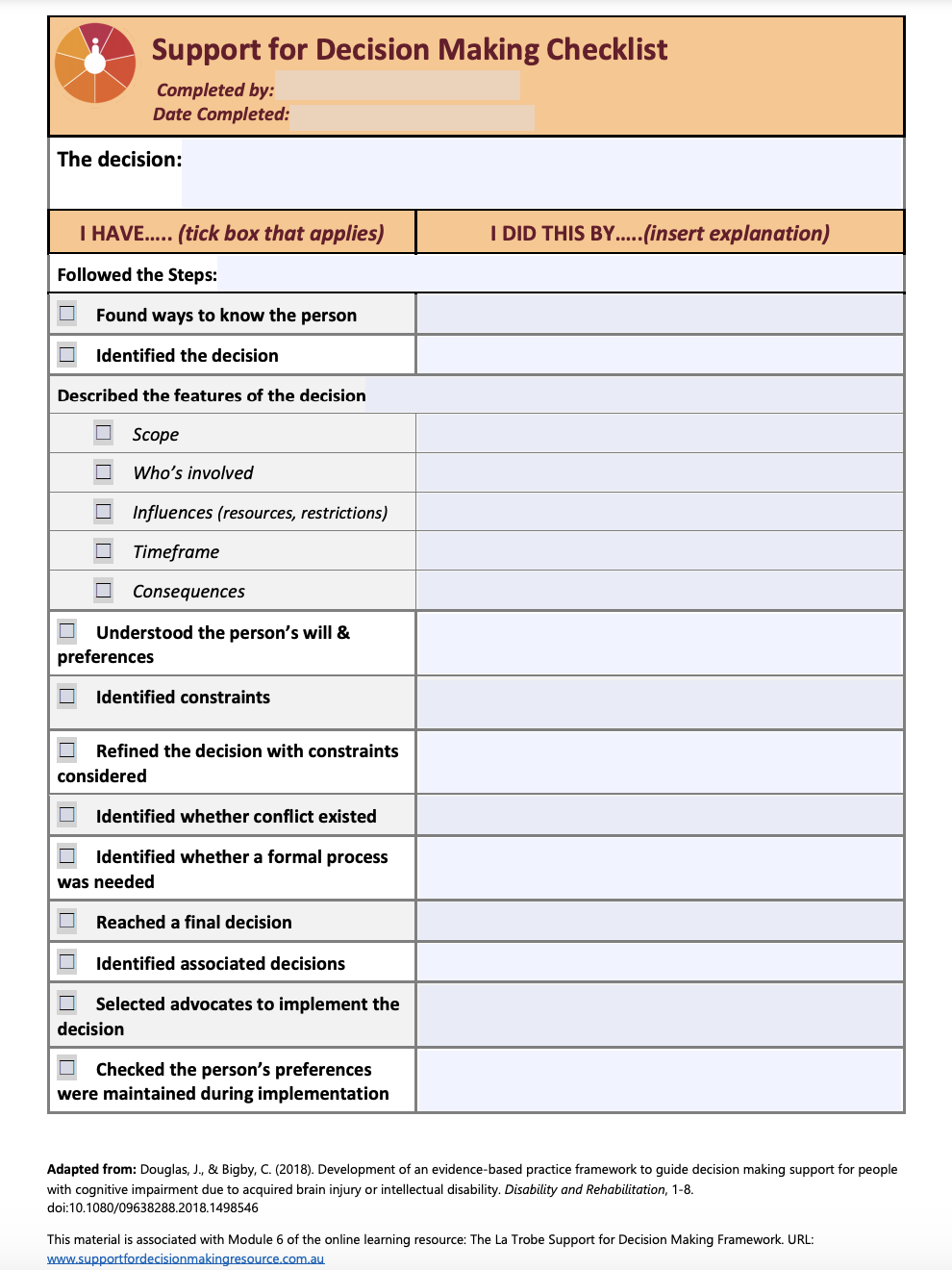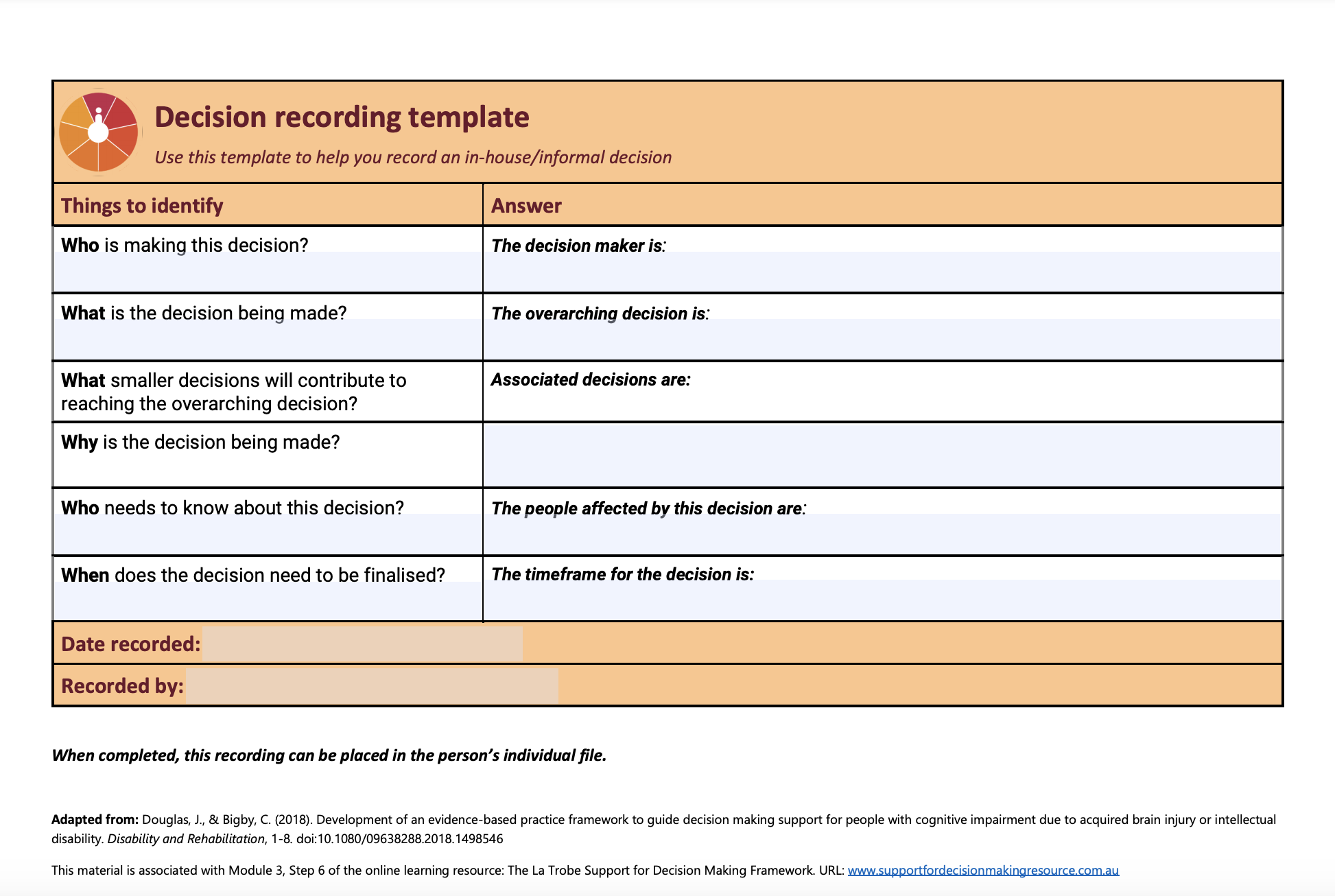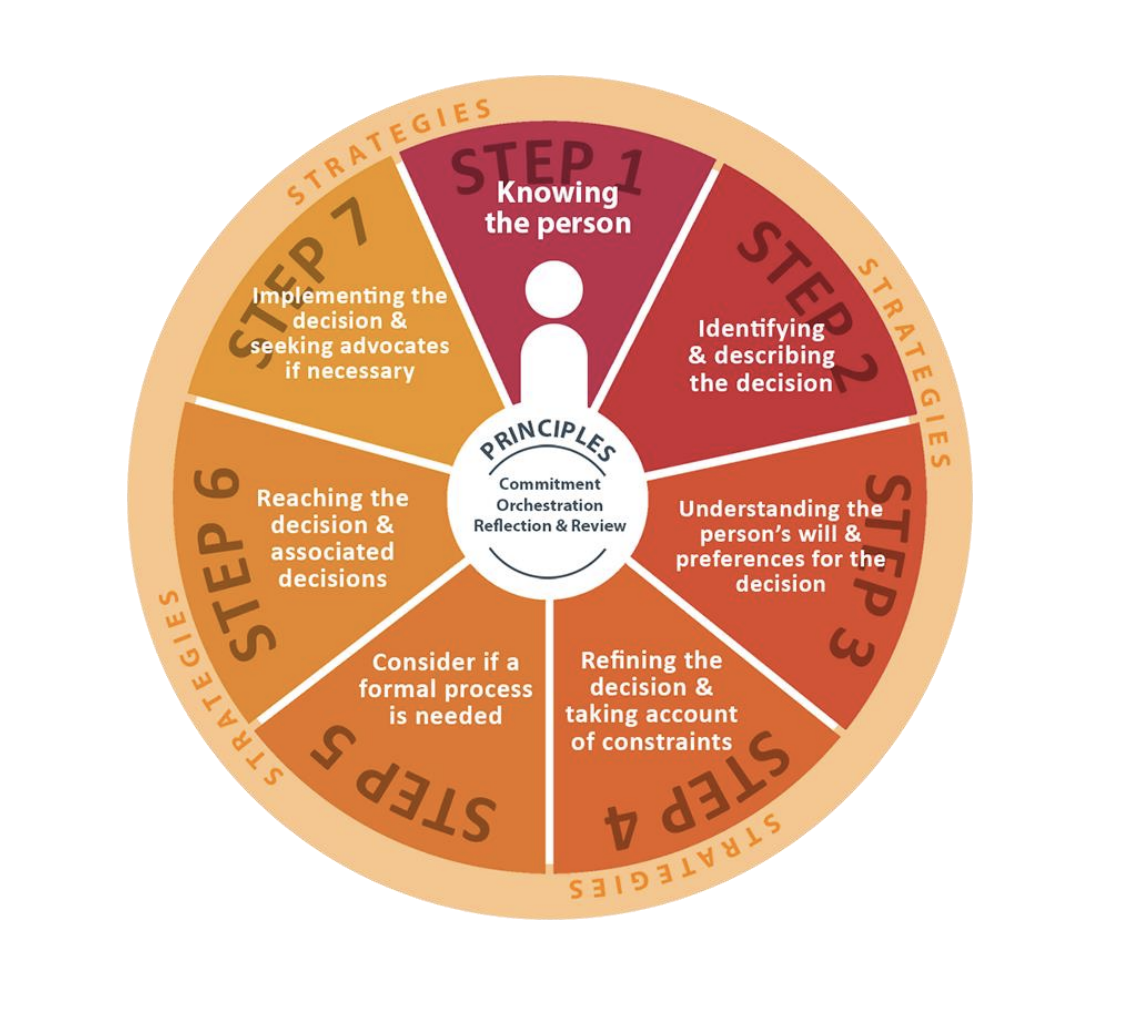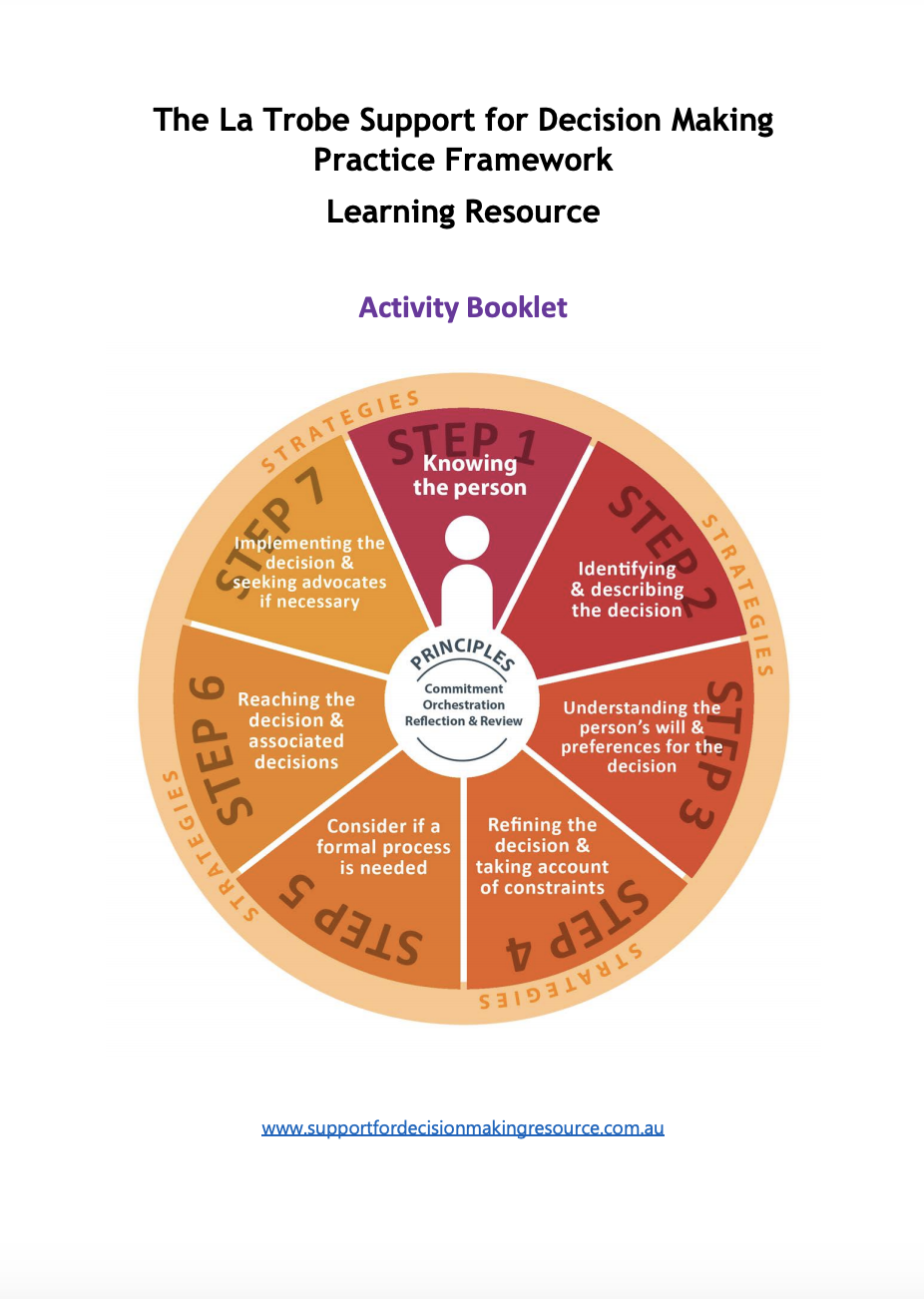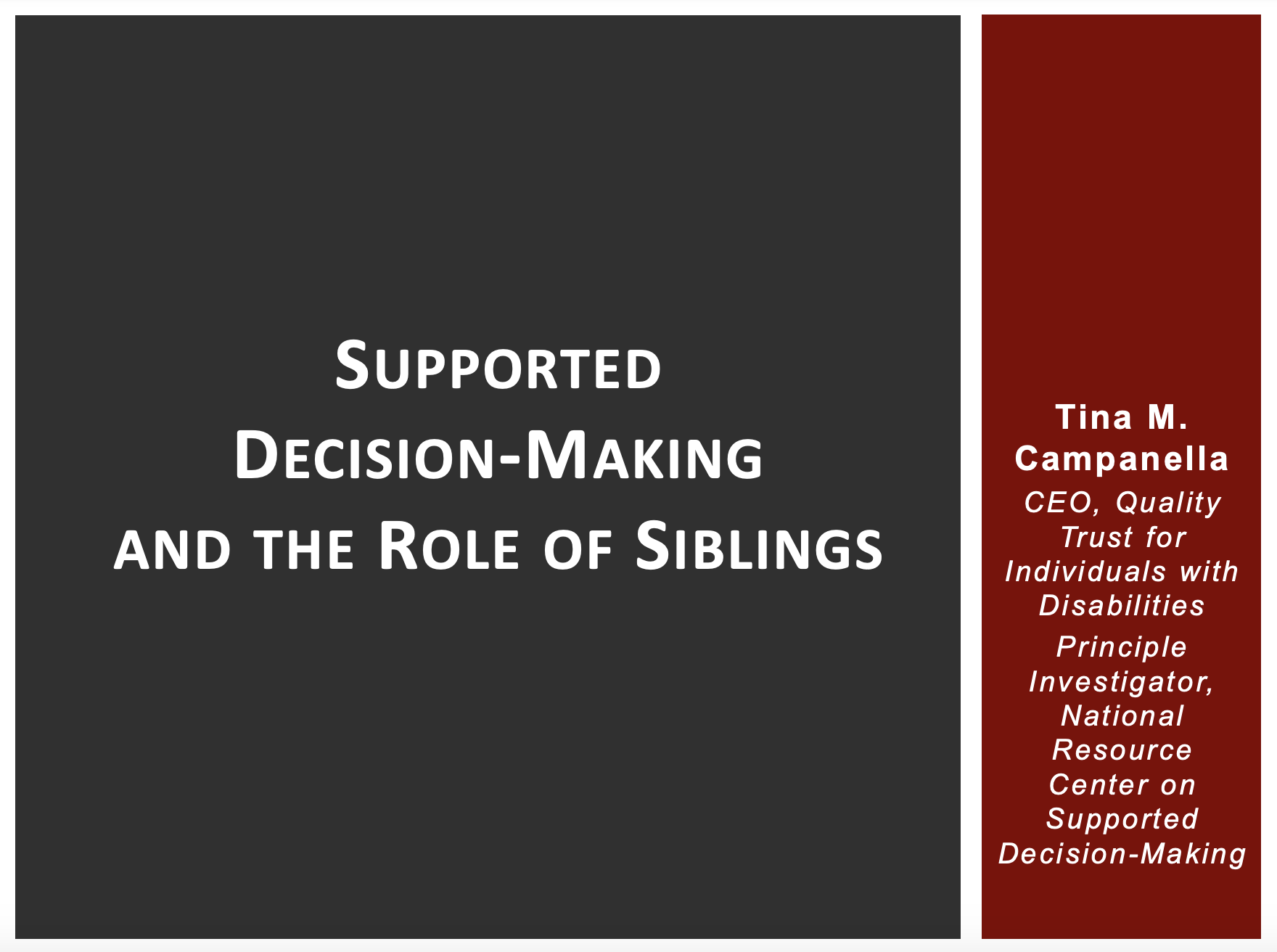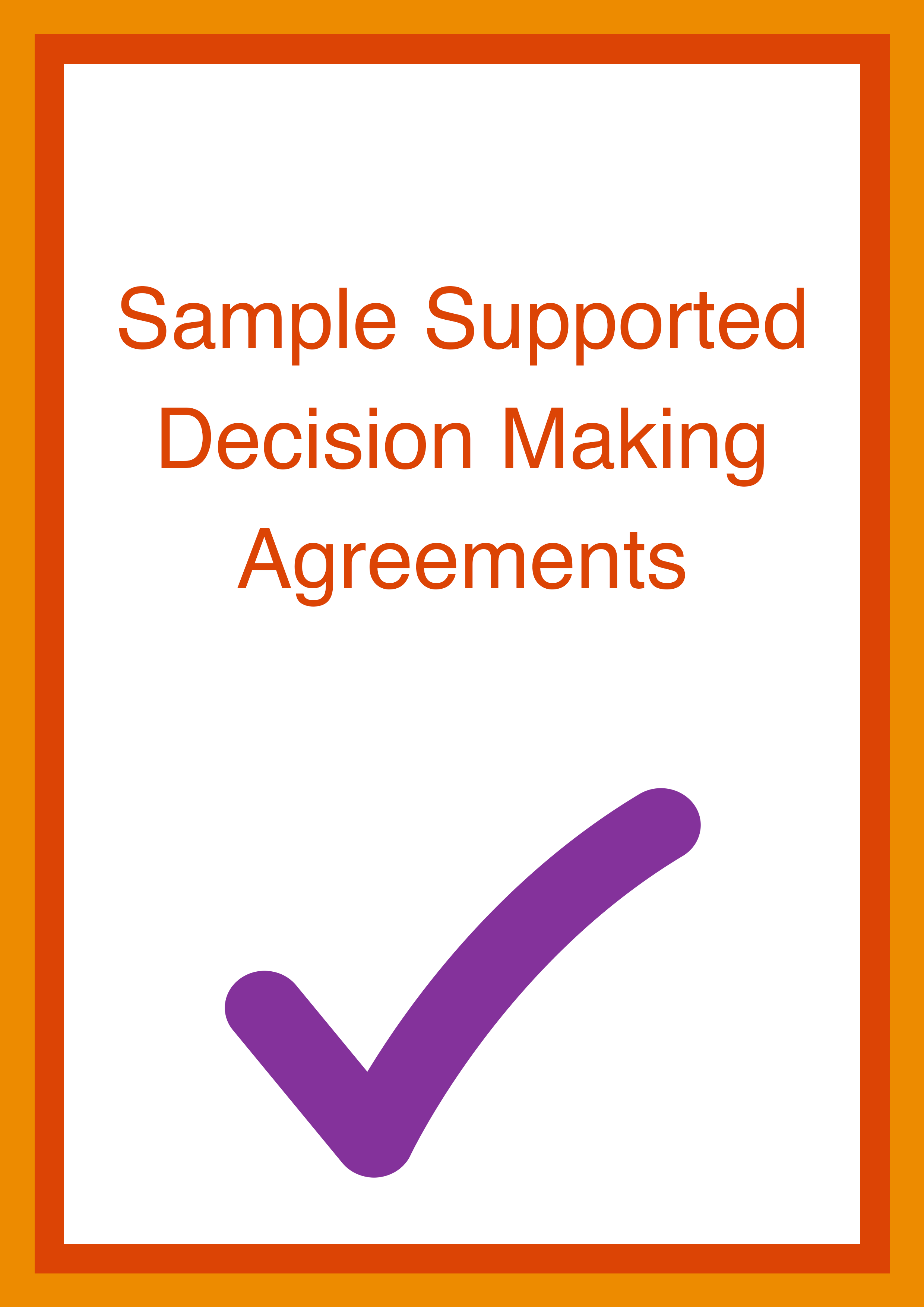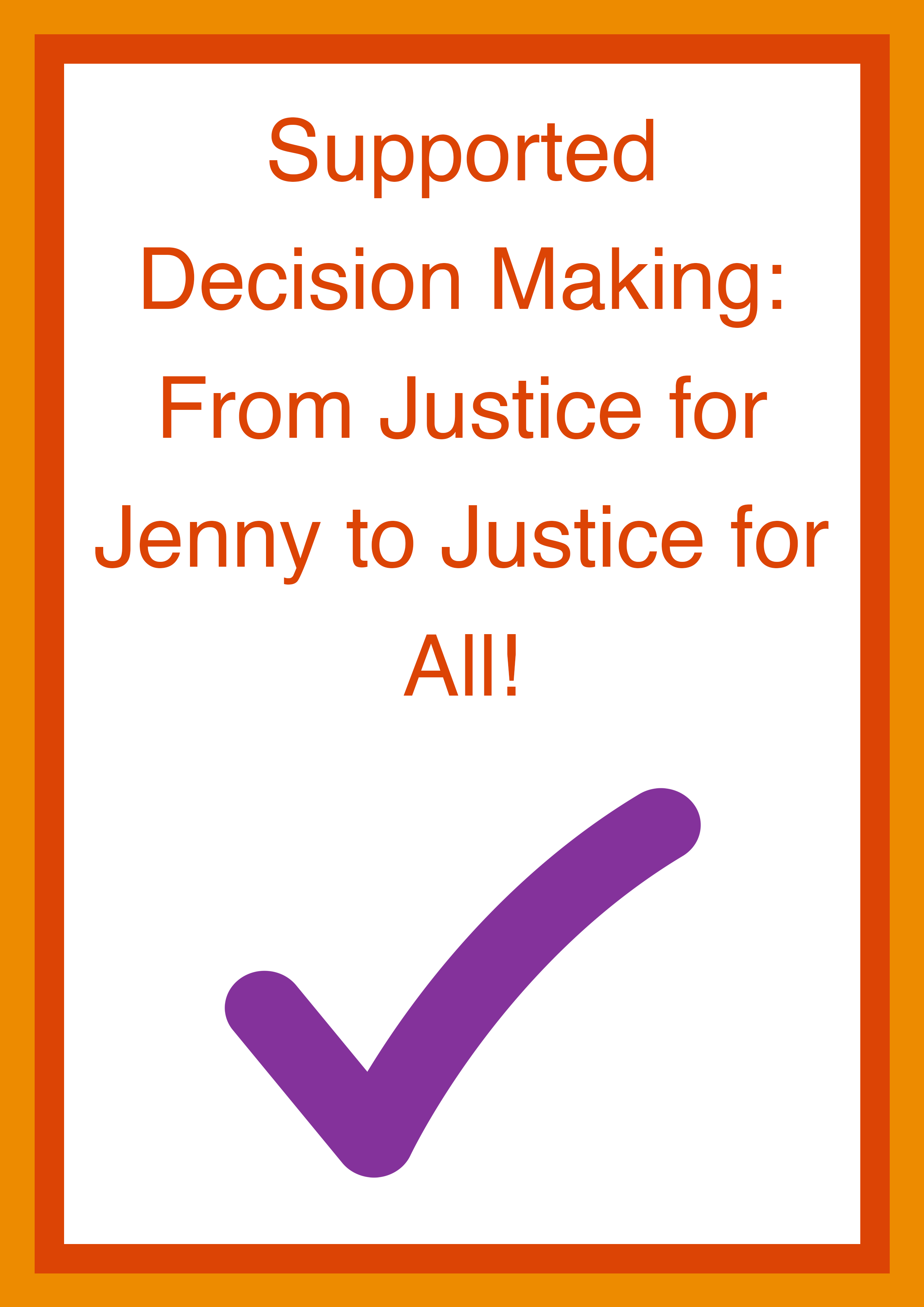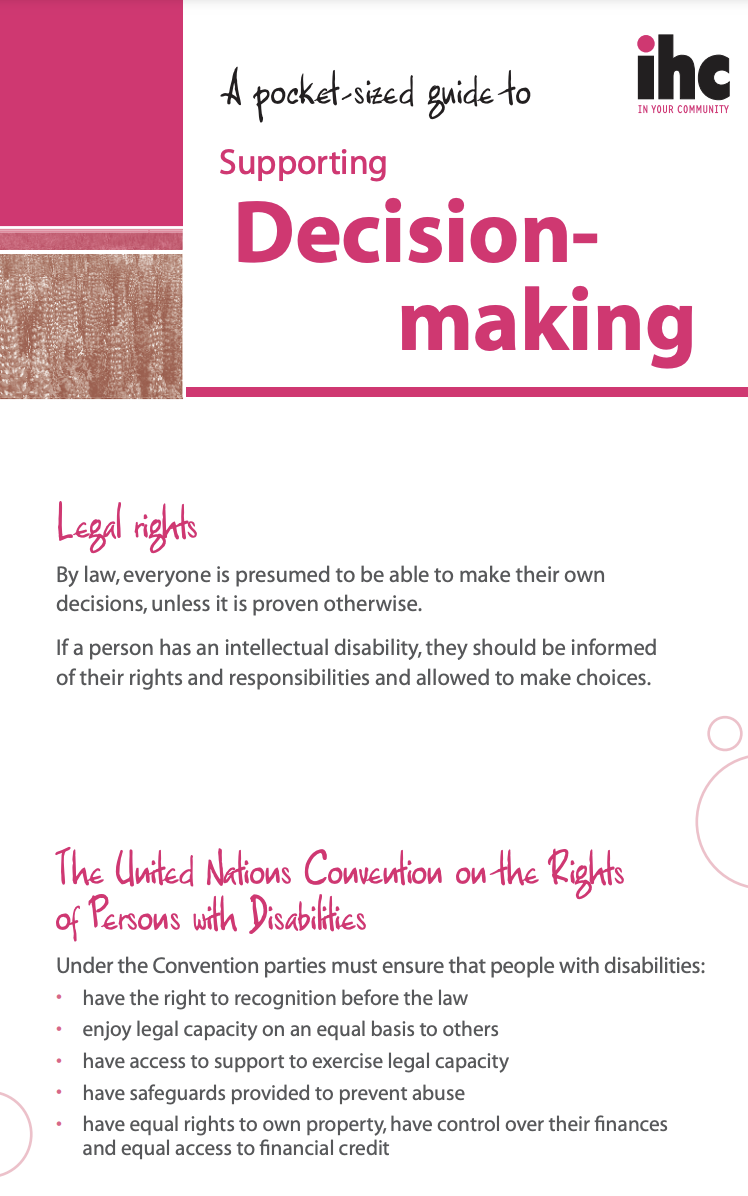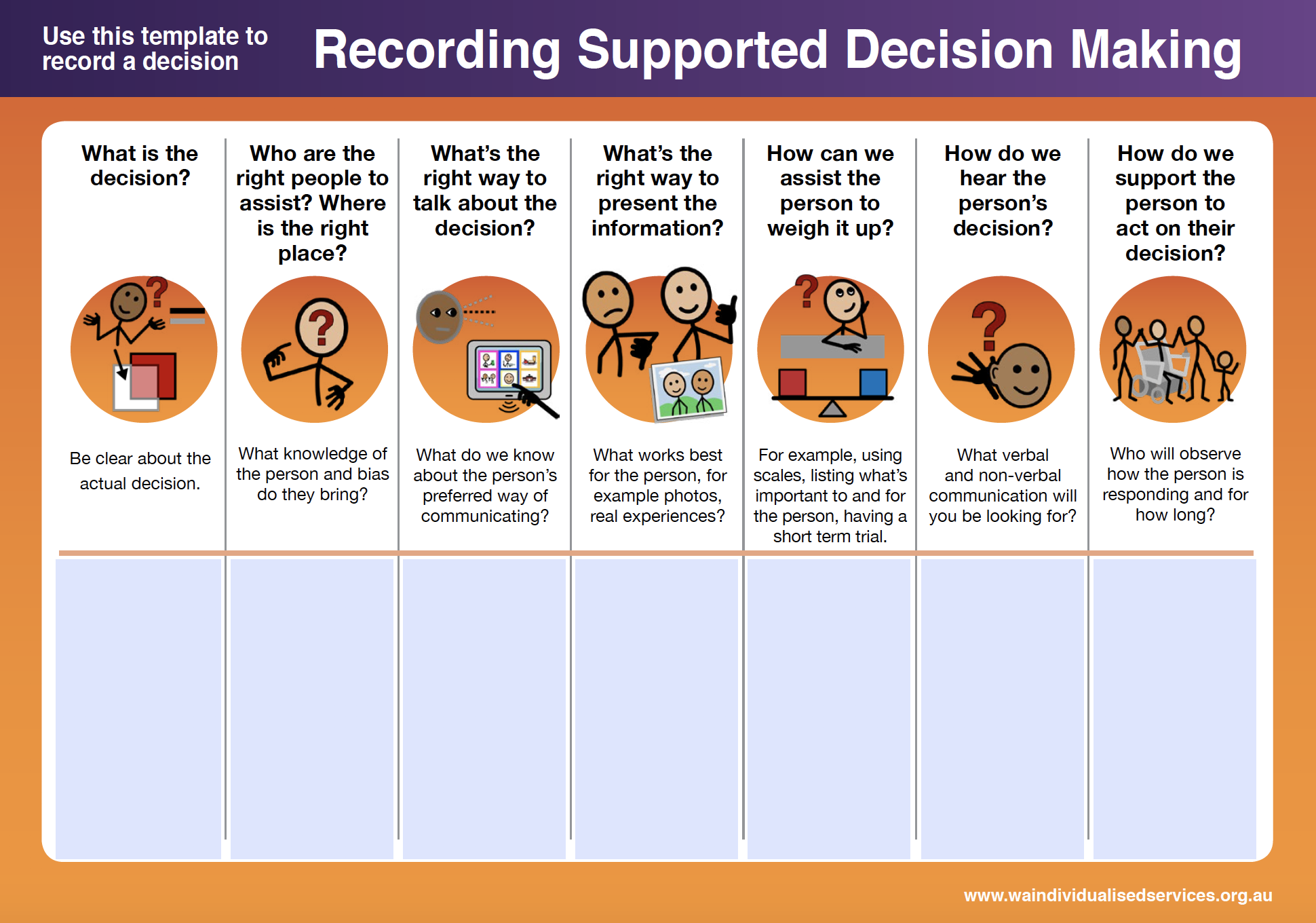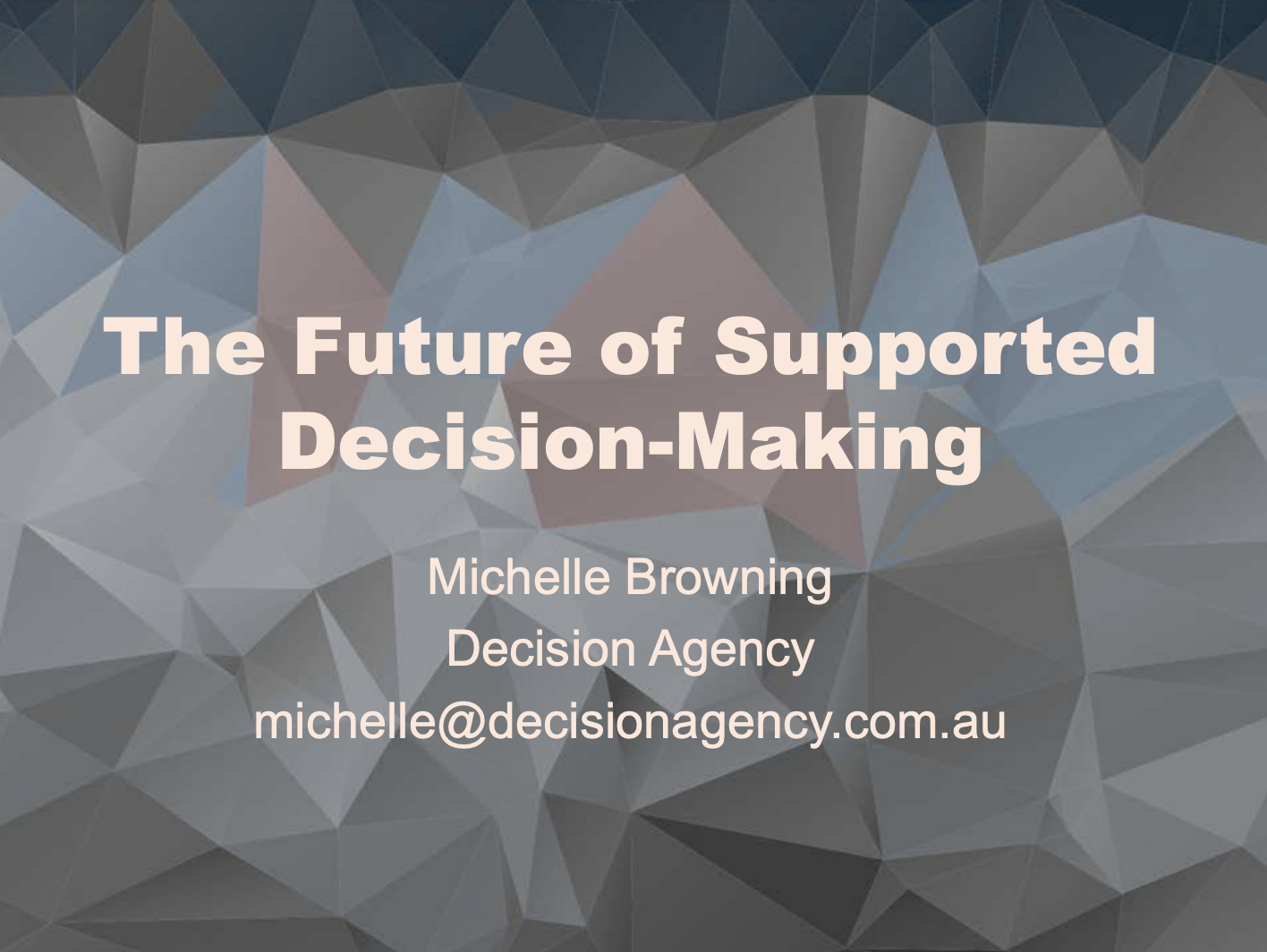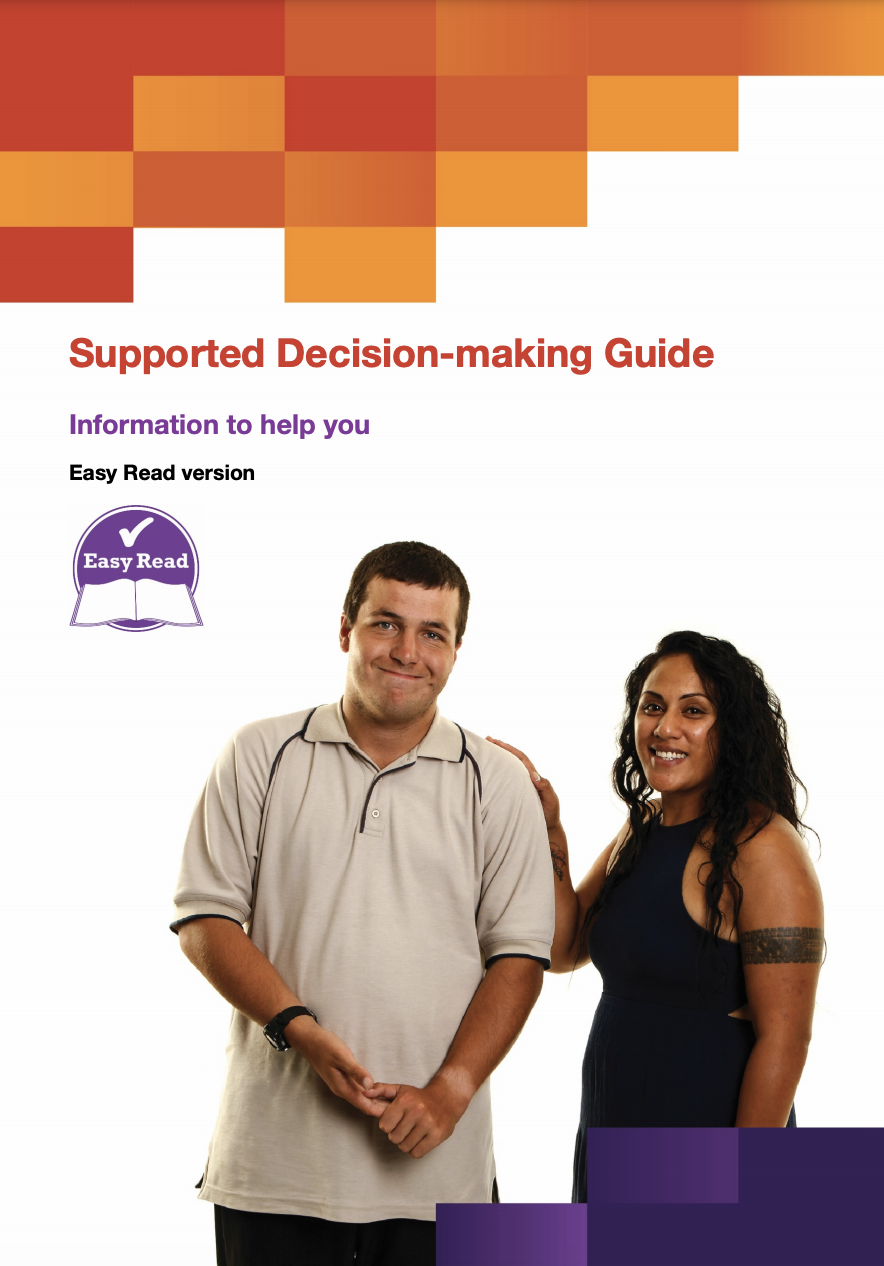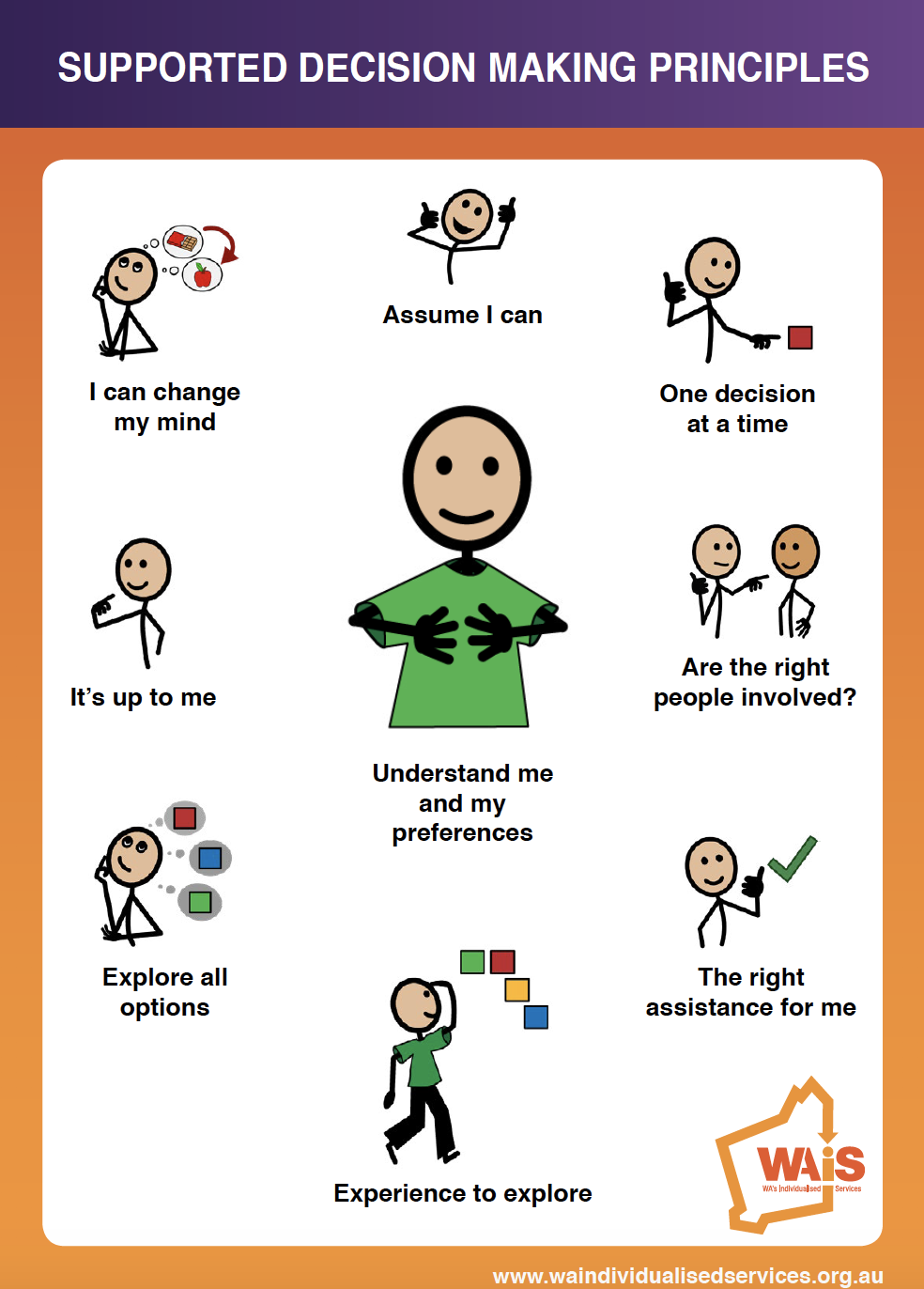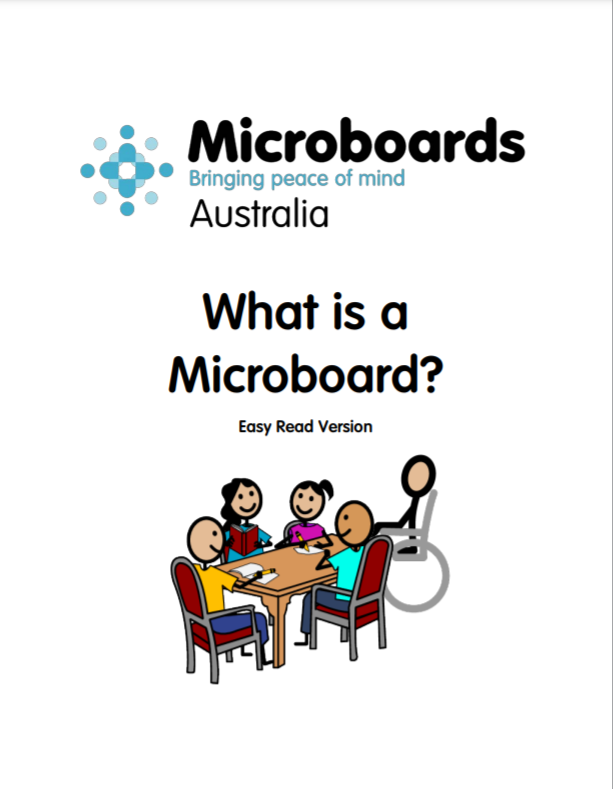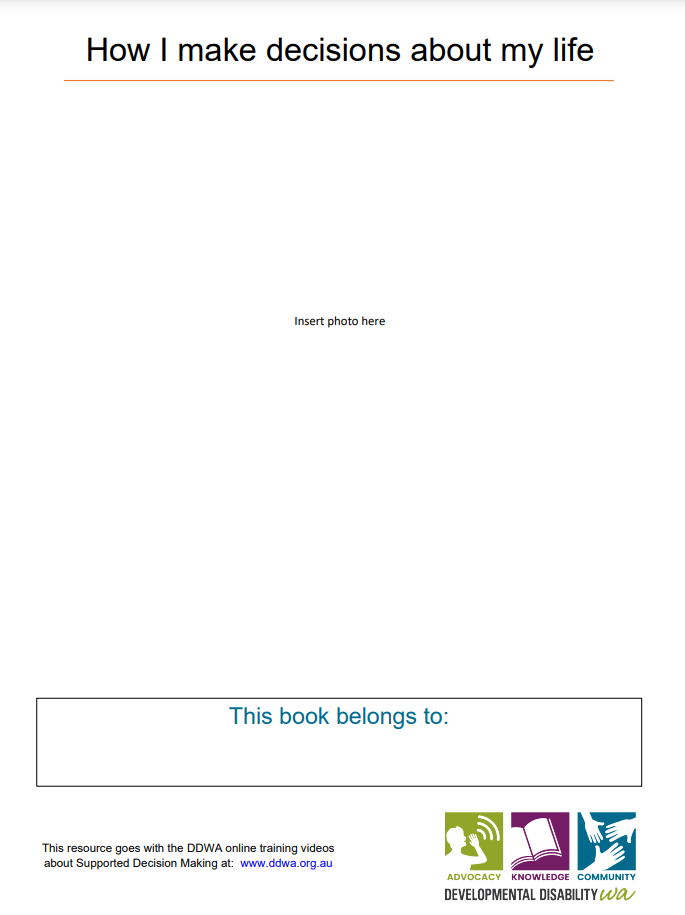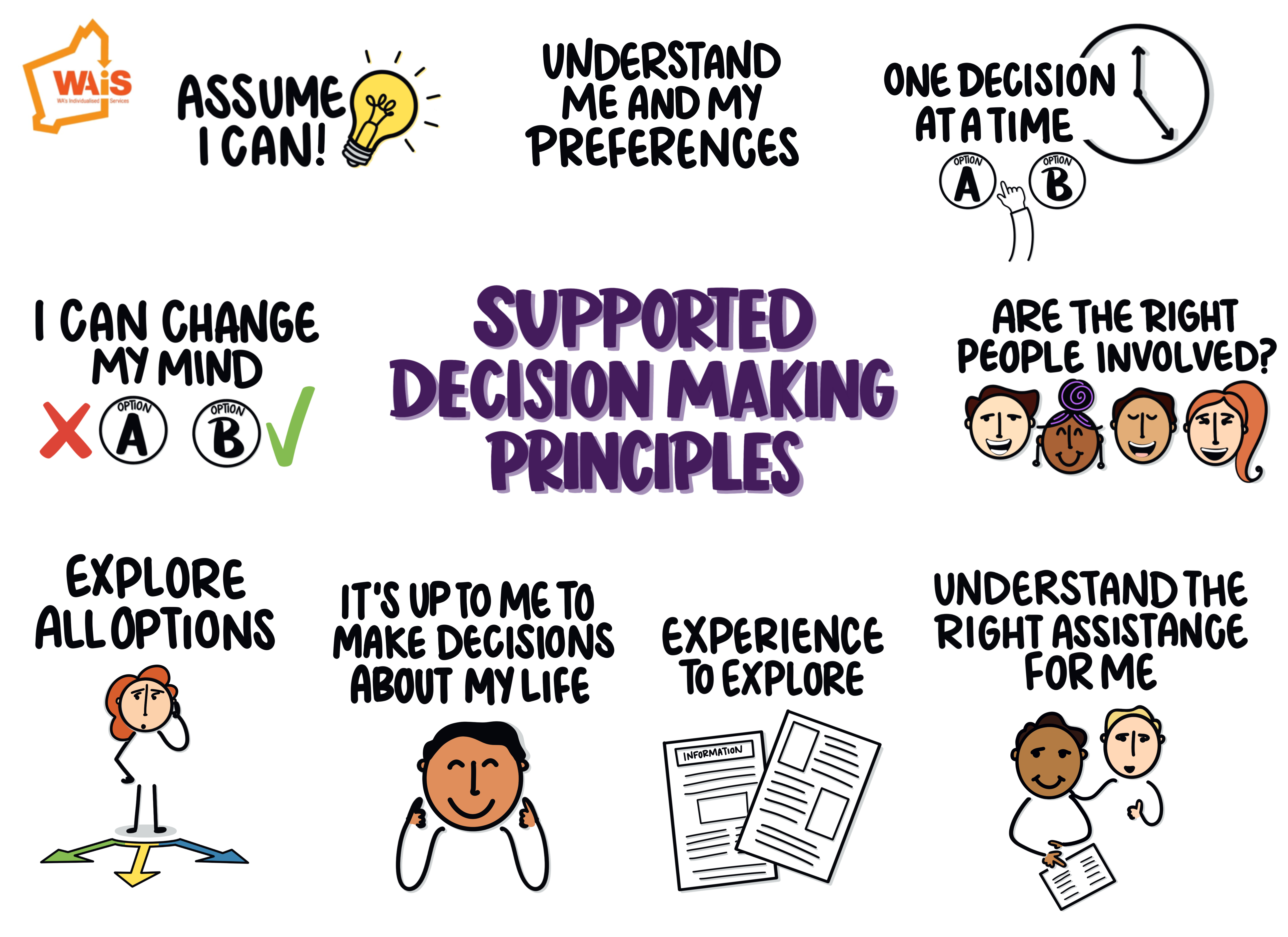Practice
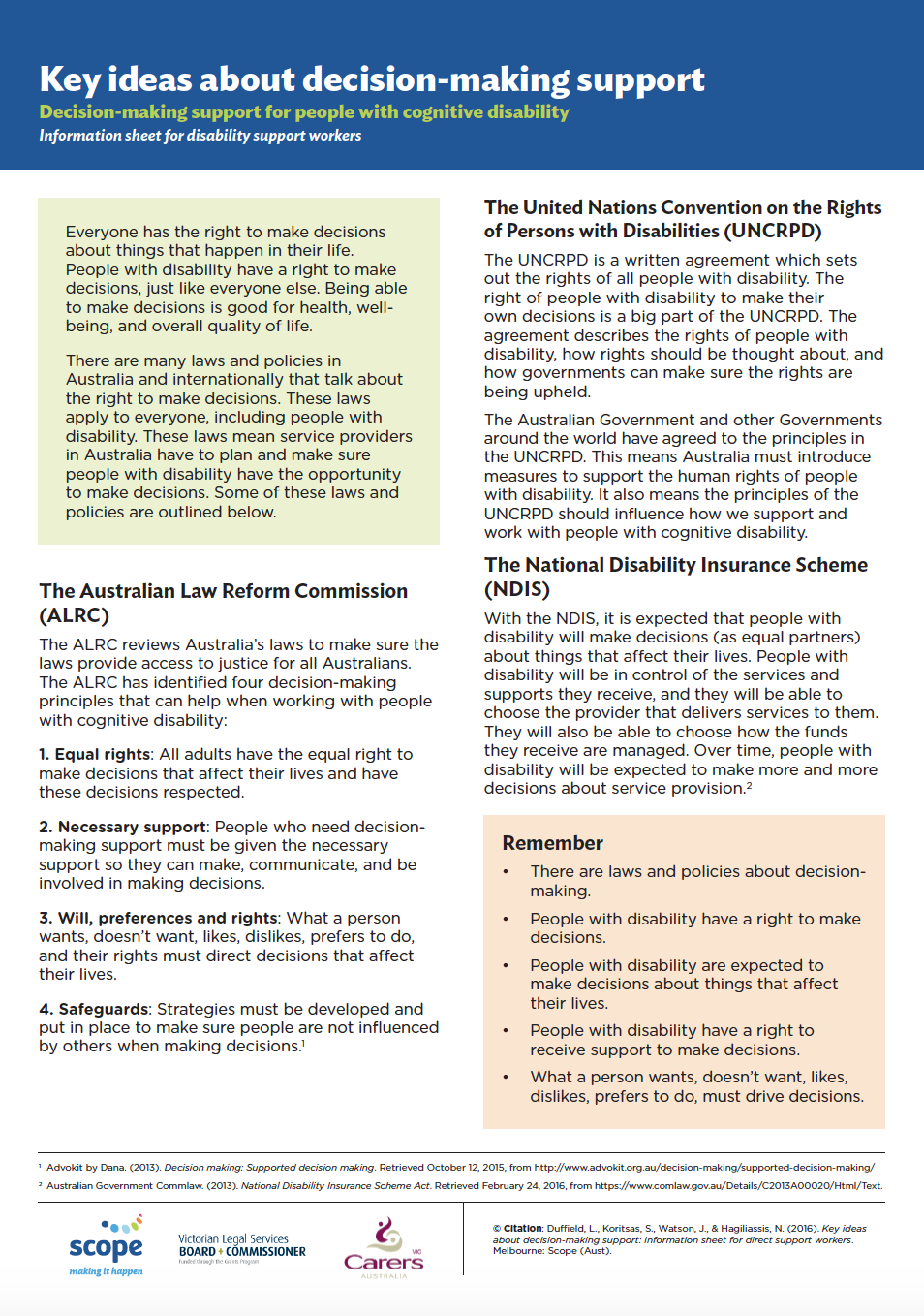
Key Ideas About Decision-Making Support
A one page information sheet outlining some key ideas about decision-making support. It talks about how The Australian Law Reform Commission (ALRC), The United Nations Convention on the Rights of Persons with Disabilities (UNCRPD) and The National Disability Insurance Scheme (NDIS) are all put in place to ensure all people have the rights to make decisions about their lives.
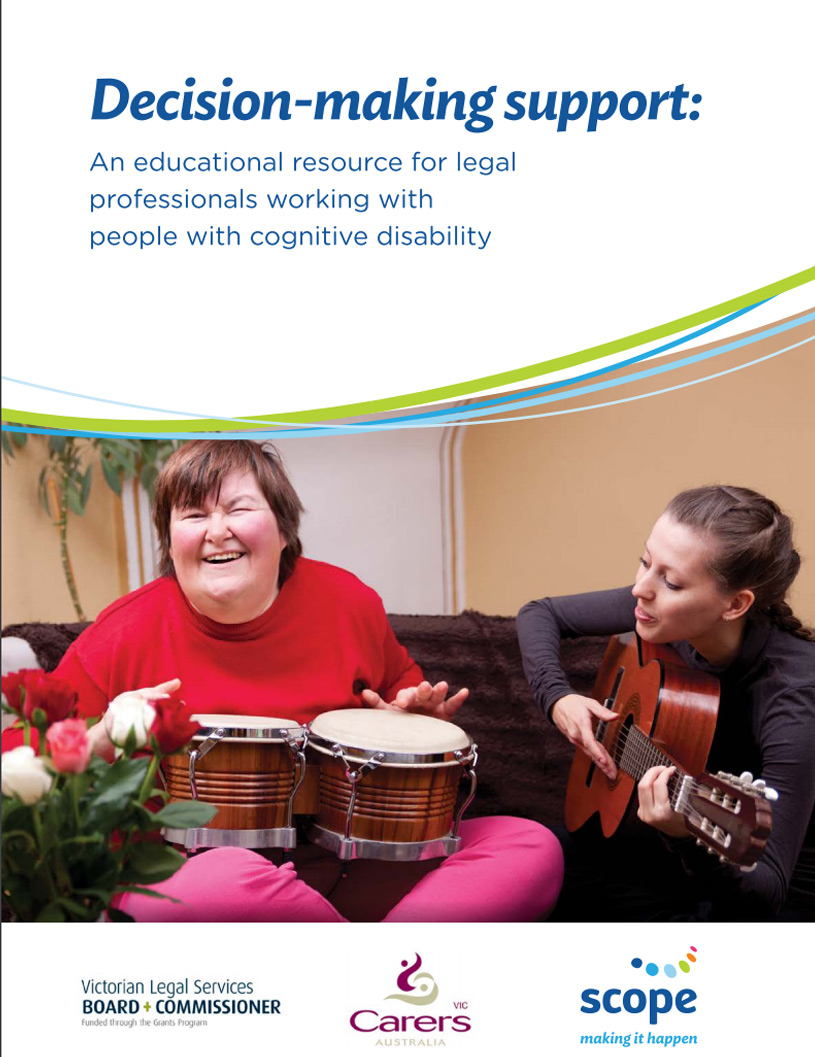
Decision Making Support: An Educational Resource for Legal Professionals Working with People with Cognitive Disability
Often, people with cognitive disability want support to make decisions. Indeed all people often want or need support to make decisions. This booklet sets out guidelines for legal professionals to assist people with cognitive disability make decisions.
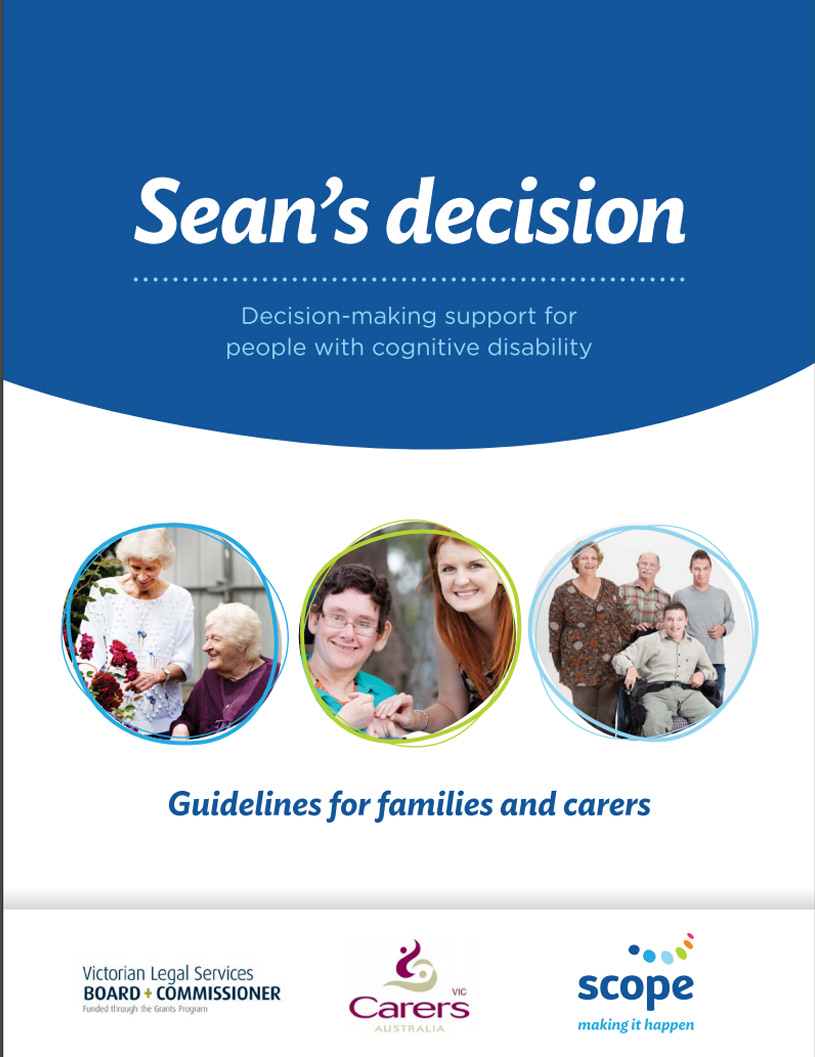
Sean’s Decision: Decision Making Support for People with Cognitive Disability
This booklet sets out guidelines for families and supporters – including siblings, friends and others – to help people with cognitive disability make decisions.
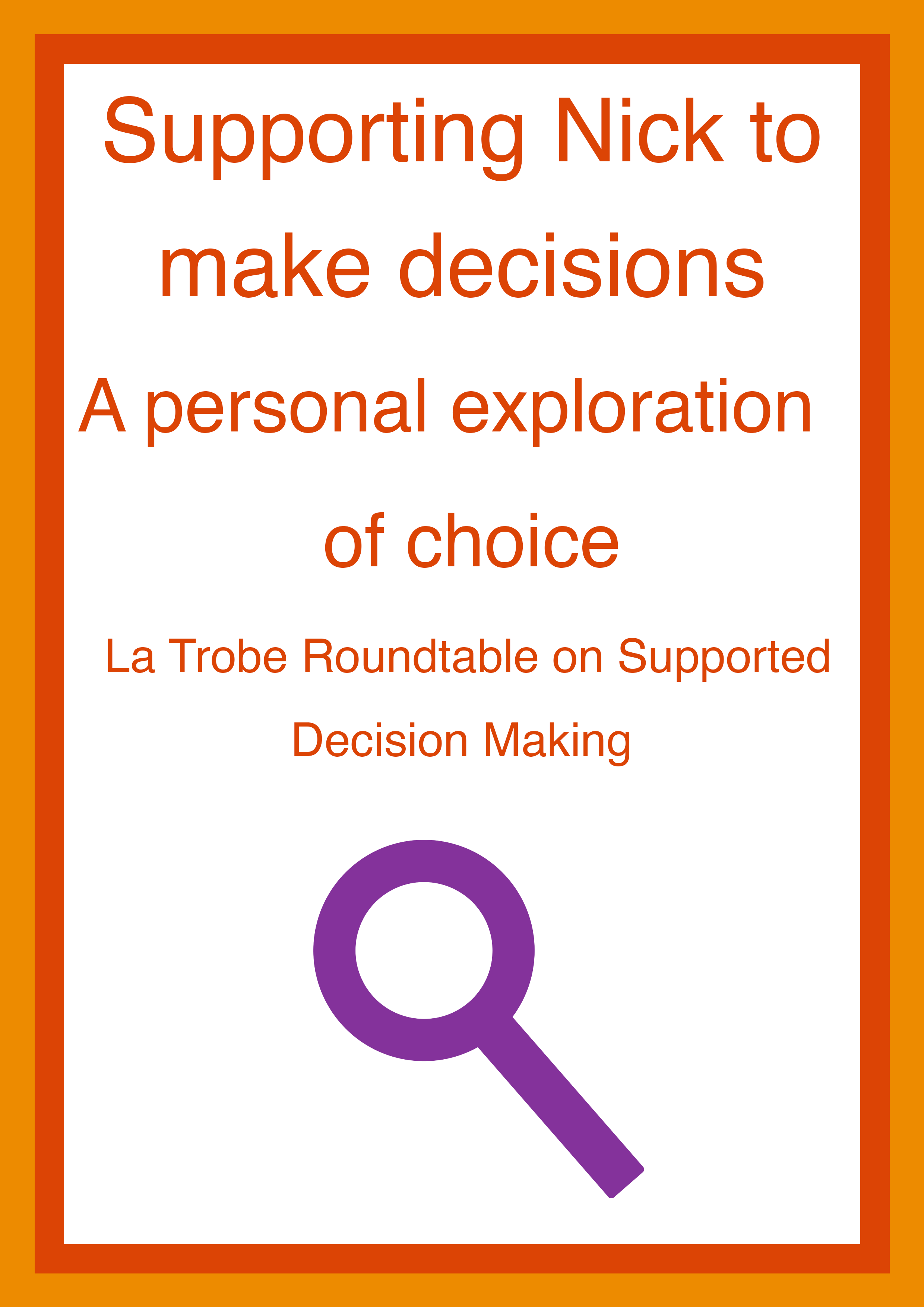
Supporting Nick to make decisions: A personal exploration of choice
Nick likes to make decisions. To make decisions about his life puts him in control. They also provide him with opportunities to learn. Nick is an energetic young man, who has strong family connections and friendships, an adored long time girlfriend, and a desire for a life of his own, separate from his parents. He also has cerebral palsy, an intellectual disability and epilepsy. The impact of these conditions are that he is unable to speak, and needs a walking frame or wheelchair to get around. He is impulsive and his sense of danger is variable and dependent on his mood and focus at the time. This paper highlights the question “What do we need to do to support Nick’s choices?”
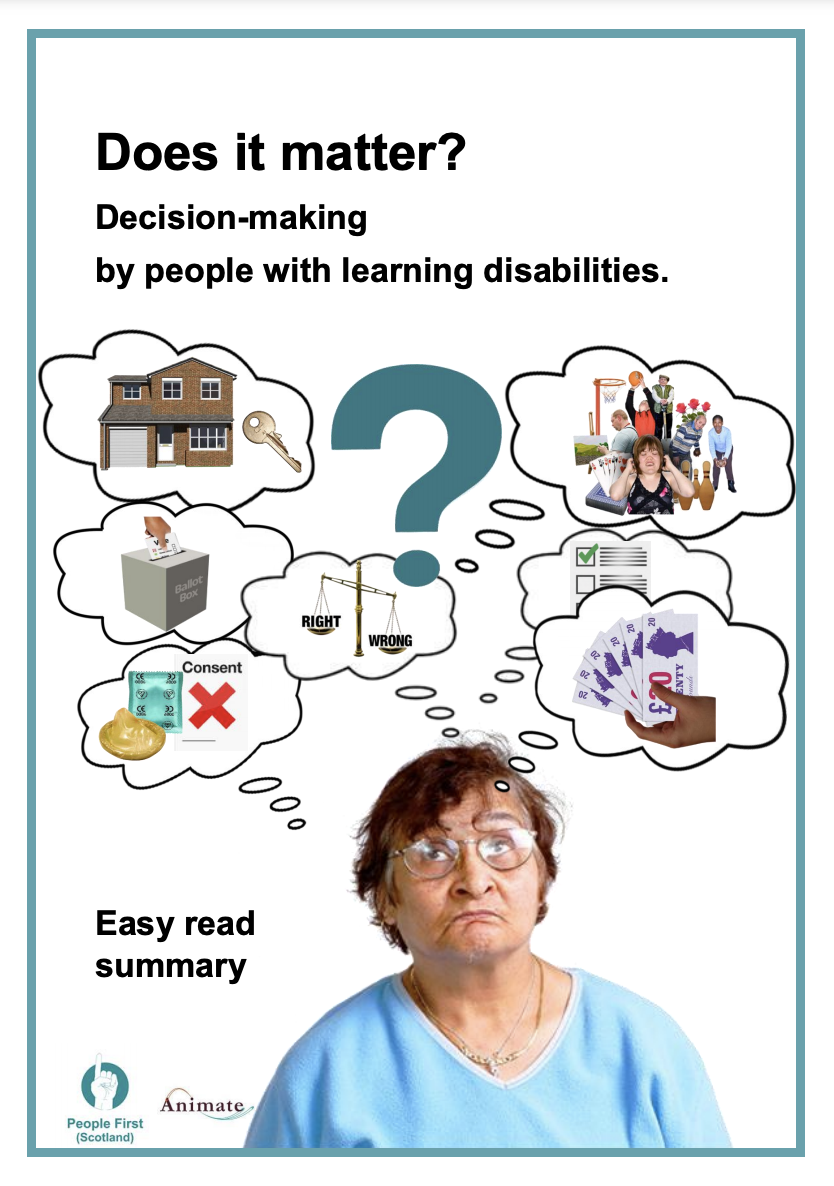
Does it matter? Decision-making by People with Learning Disabilities.
An easy read report, by People First Scotland, about the research they did on decisions and decision-making by adults with learning disabilities. The research aimed to answer the question ‘Does it matter to people with learning disabilities whether they are supported to make their own decisions or have others make decisions for them in their lives?’.
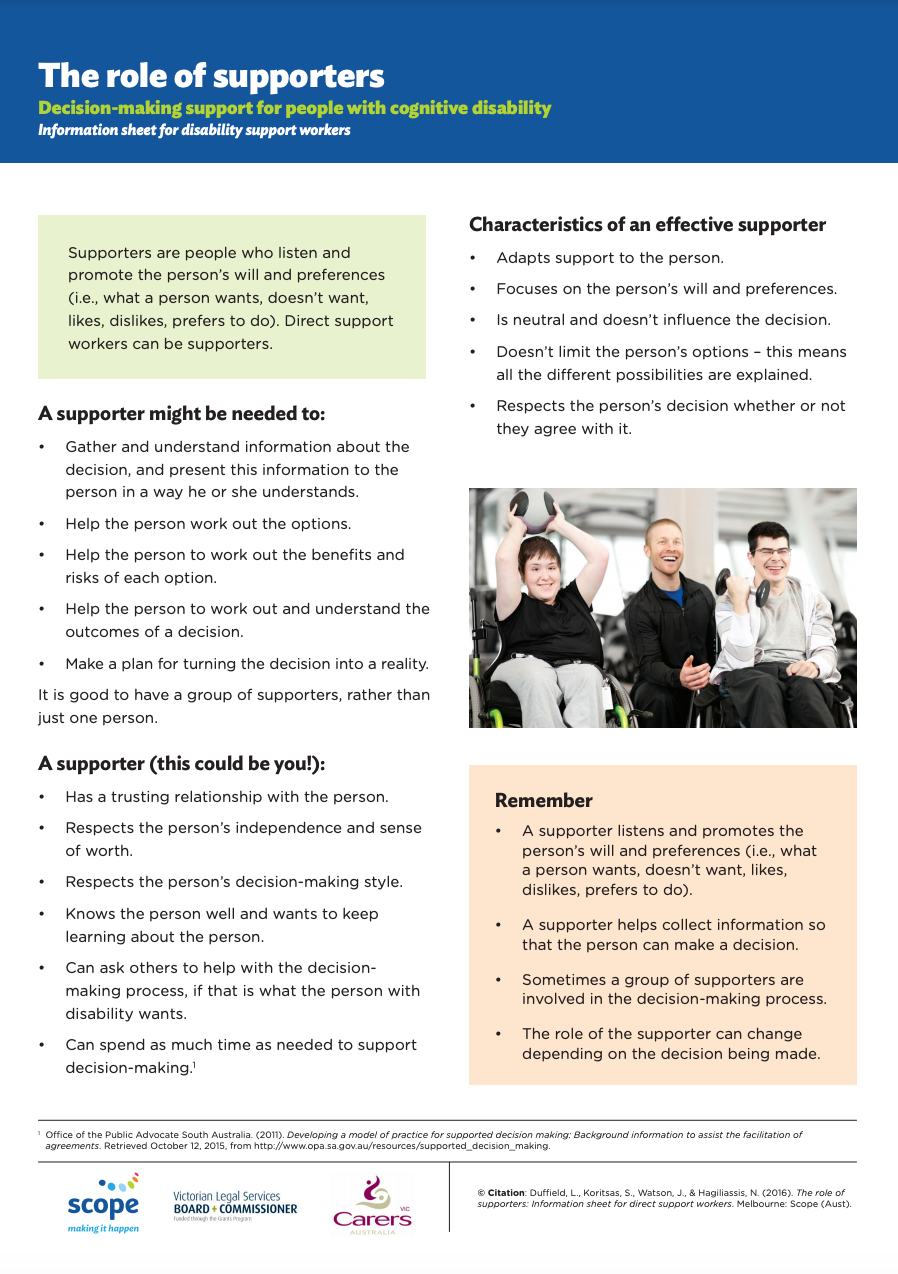
The Role of Supporters
This is a factsheet about the role of supporters of people with disability. Supporters are people who listen and promote the person’s will and preferences (i.e., what a person wants, doesn’t want, likes, dislikes, prefers to do).
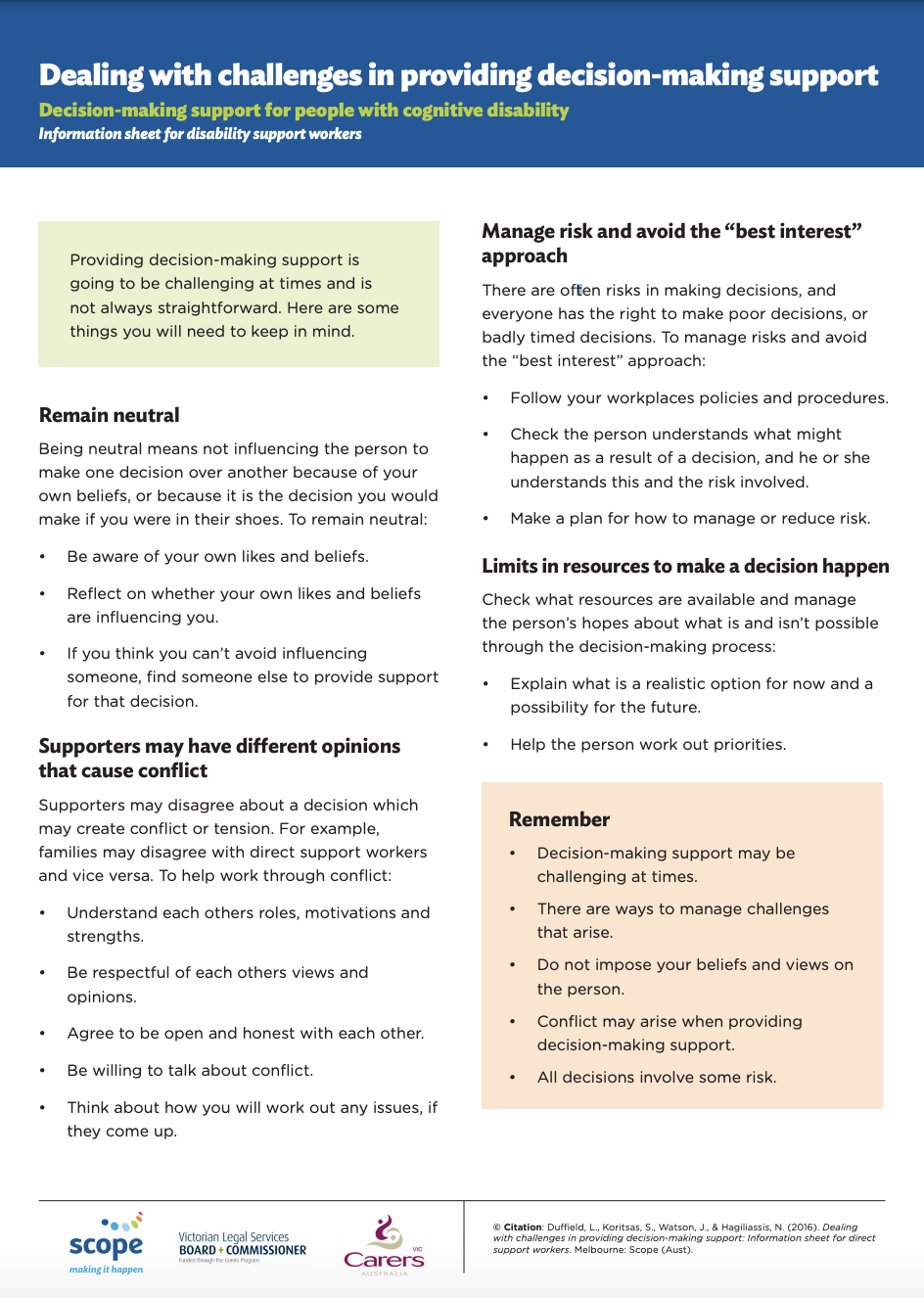
Dealing with Challenges in Providing Decision-Making Support
Providing decision-making support is going to be challenging at times and is not always straightforward. Here are some things you will need to keep in mind.
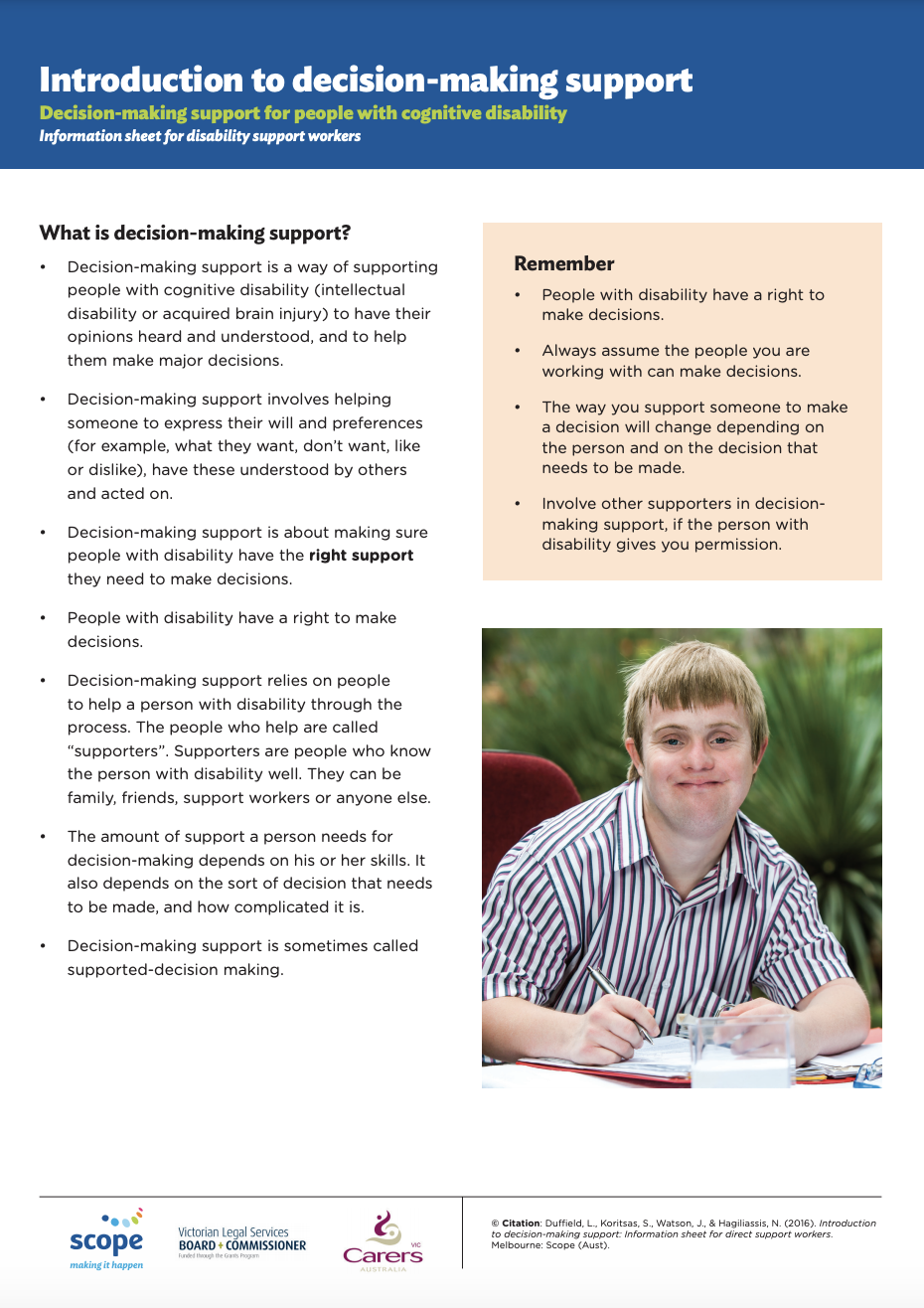
Introduction to Decision-Making Support
This is a factsheet designed for support workers about decision-making support. Decision-making support is a way of supporting people with cognitive disability (intellectual disability or acquired brain injury) to have their opinions heard and understood, and to help them make major decisions.
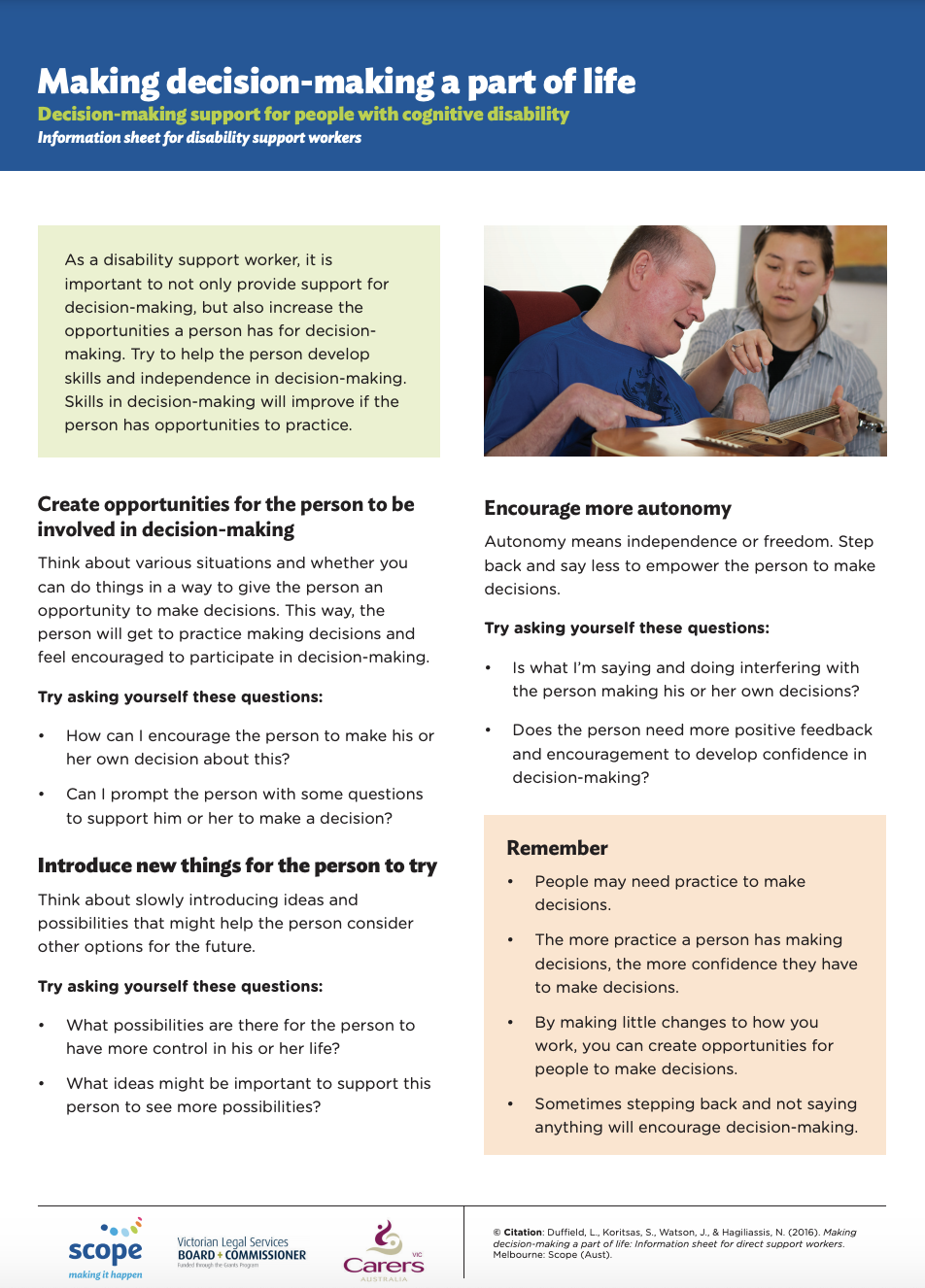
Making Decision-Making a Part of Life
As a disability support worker, it is important to not only provide support for decision-making, but also increase the opportunities a person has for decision making. Try to help the person develop skills and independence in decision-making. Skills in decision-making will improve if the person has opportunities to practice. This factsheet is designed for support workers supporting people with decision making.
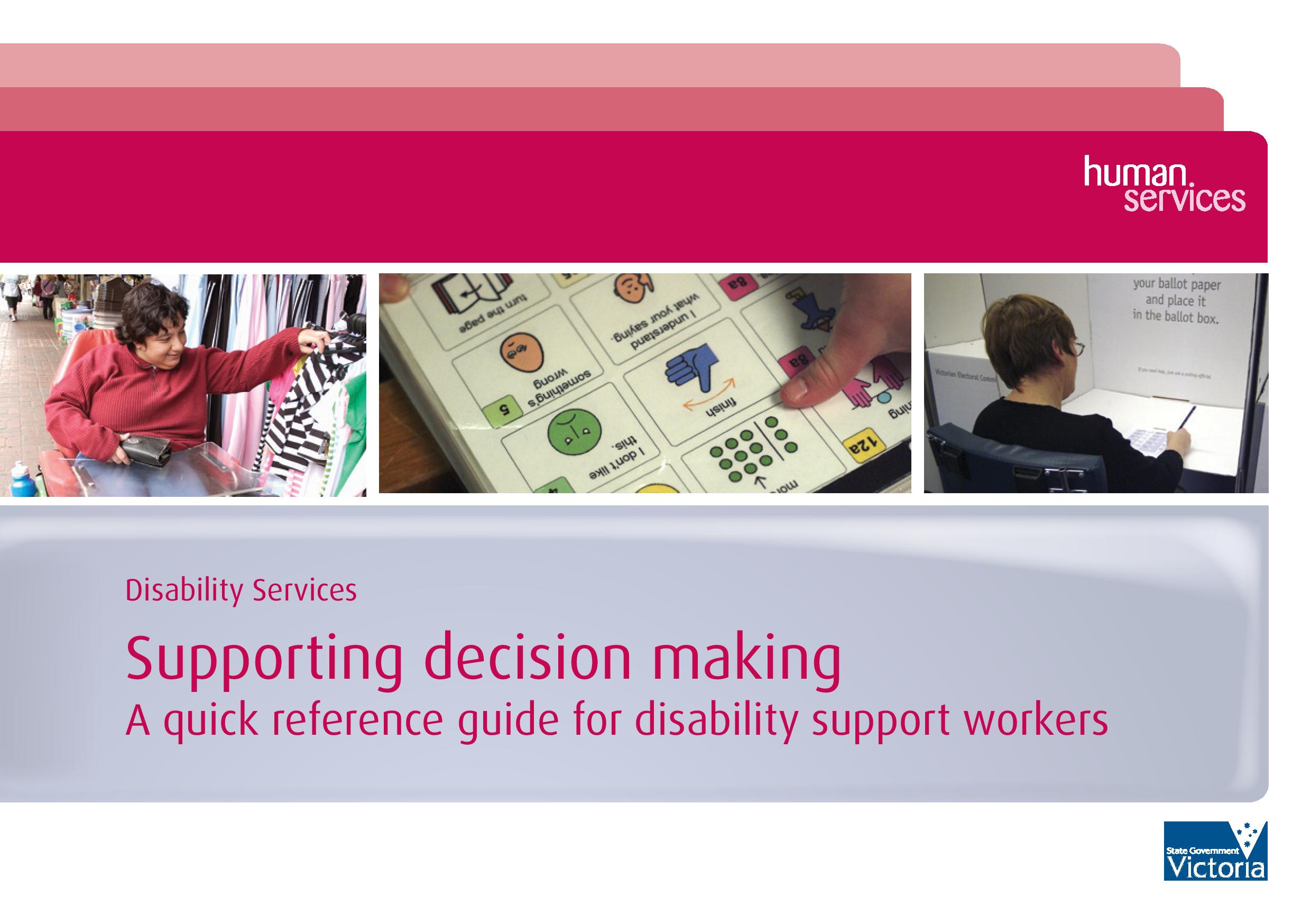
Disability Services Supporting decision making: A quick reference guide for disability support workers
This Supporting Decision Making quick reference guide is for staff who work with people with a disability who are making decisions. Legislation and policy strongly supports people to exercise choice and control over their disability supports. For this to be effective, people need to be supported, where needed, to make decisions about the things that are important to them.
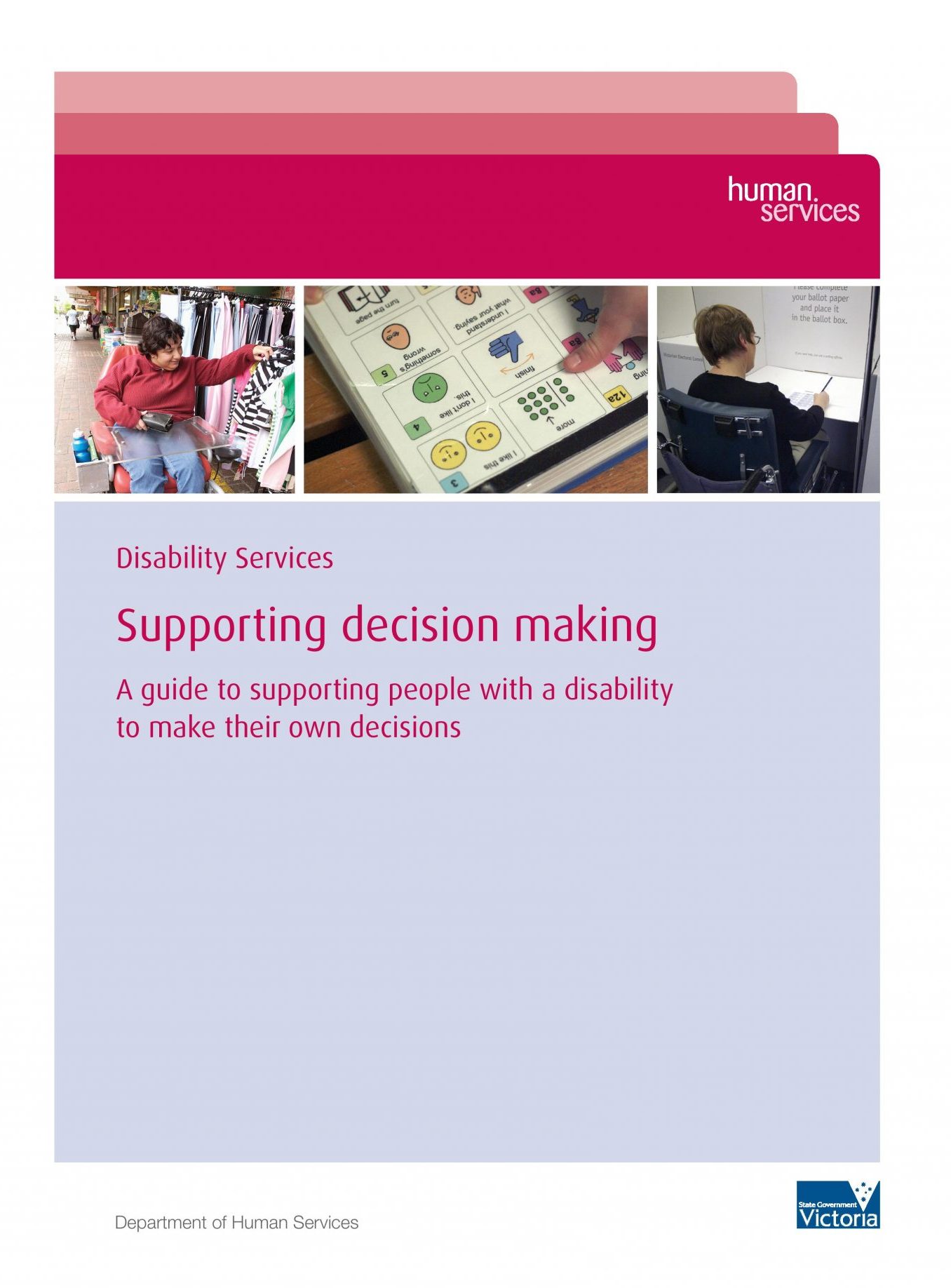
Supporting decision making: A guide to supporting people with a disability to make their own decisions
The freedom to make decisions which affect our lives is a fundamental right that each of us should enjoy.
The decisions and choices that we make are a reflection of who we are as individuals. They allow us to express our views, our personalities, our desires and goals as well as to reflect what we think is important in life. Through these choices and decisions we can pursue the lifestyles that we want.
Outcomes of decisions – good and bad – help us learn and grow as individuals. Through involvement in decision making we can gain experience, confidence and knowledge which enrich our lives.
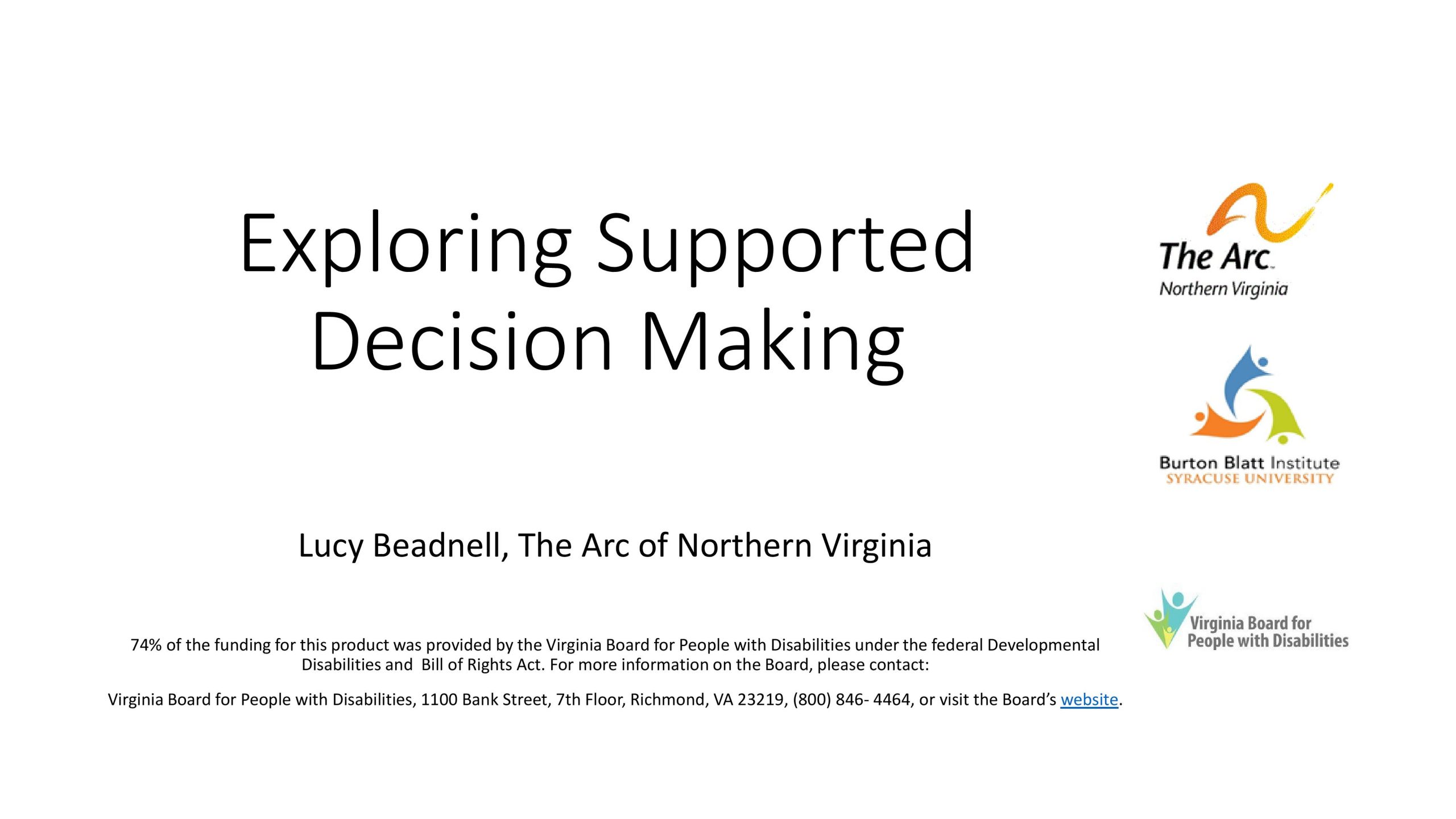
The Basics of Supported Decision Making
Supported Decision Making (SDM) is getting the help you need, from people you trust, to make your own decisions. Isn’t that how we all make decisions? We all need help when we’re faced with tough choices, or don’t understand our options, or just want some advice. It’s simple: they give you information and advice to help you make the best decision for you. They support so you can decide. SDM is very important for people with developmental disabilities who can make their own decisions when they get the support they need. For them, SDM can be used instead of more restrictive options, like guardianship. For individuals with guardians, SDM can be used to maximize self-determination.
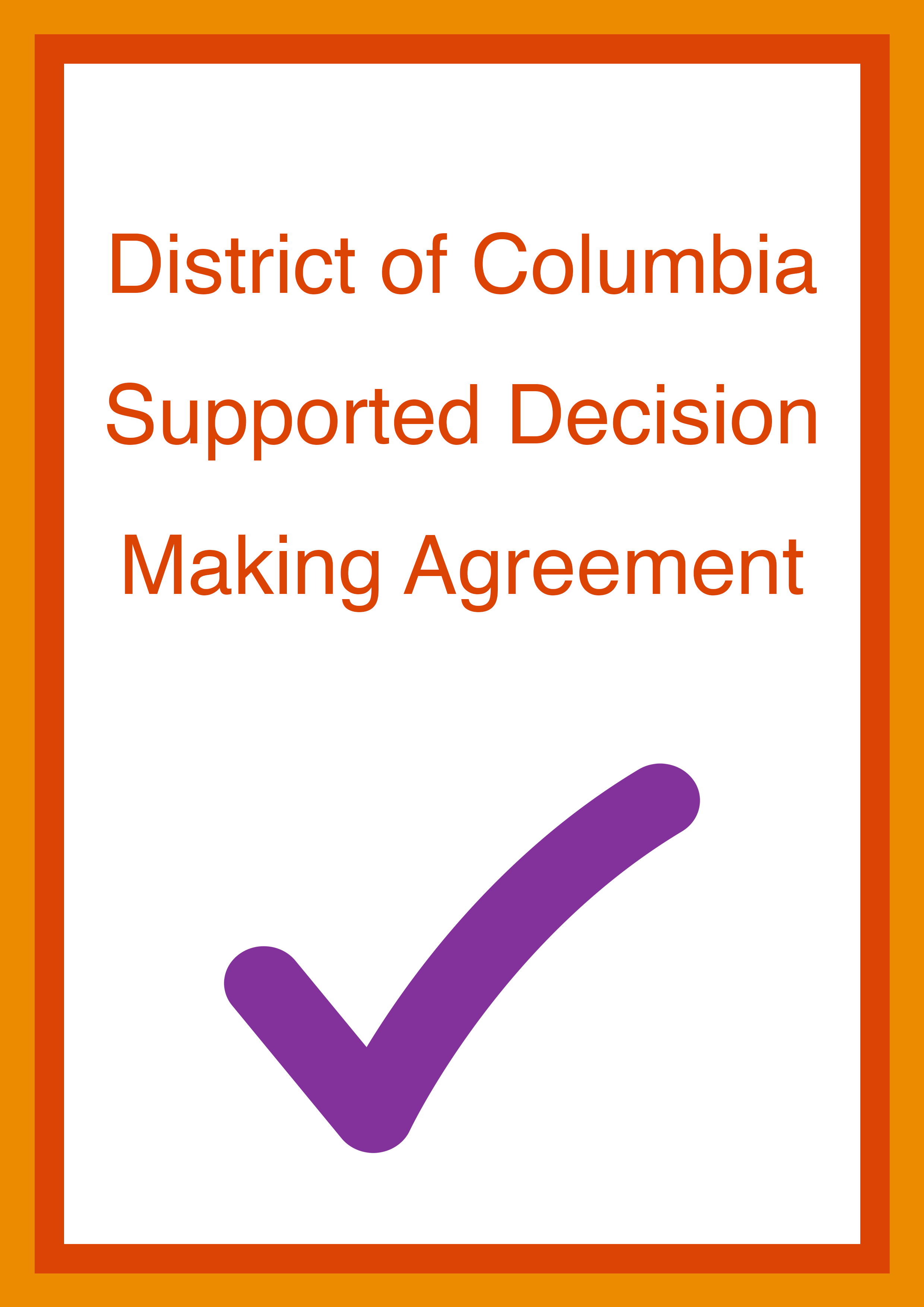
District of Columbia Supported Decision Making Agreement
Starting May 5, 2018, if you are a person with a disability, you can use the attached form to make Statutory Supported Decision‐Making Agreements (also called “SDMA”). The District of Columbia law that lets you do this is the “Disability Services Reform Amendment Act of 2018,” D.C. Law 22‐93.
The D.C. Department on Disability Services and Quality Trust for Individuals with Disabilities developed this Information and Instructions document to explain Supported Decision‐Making Agreements and help you understand how to use the SDMA form. Project ACTION! and the Family Support Council reviewed for accessibility.
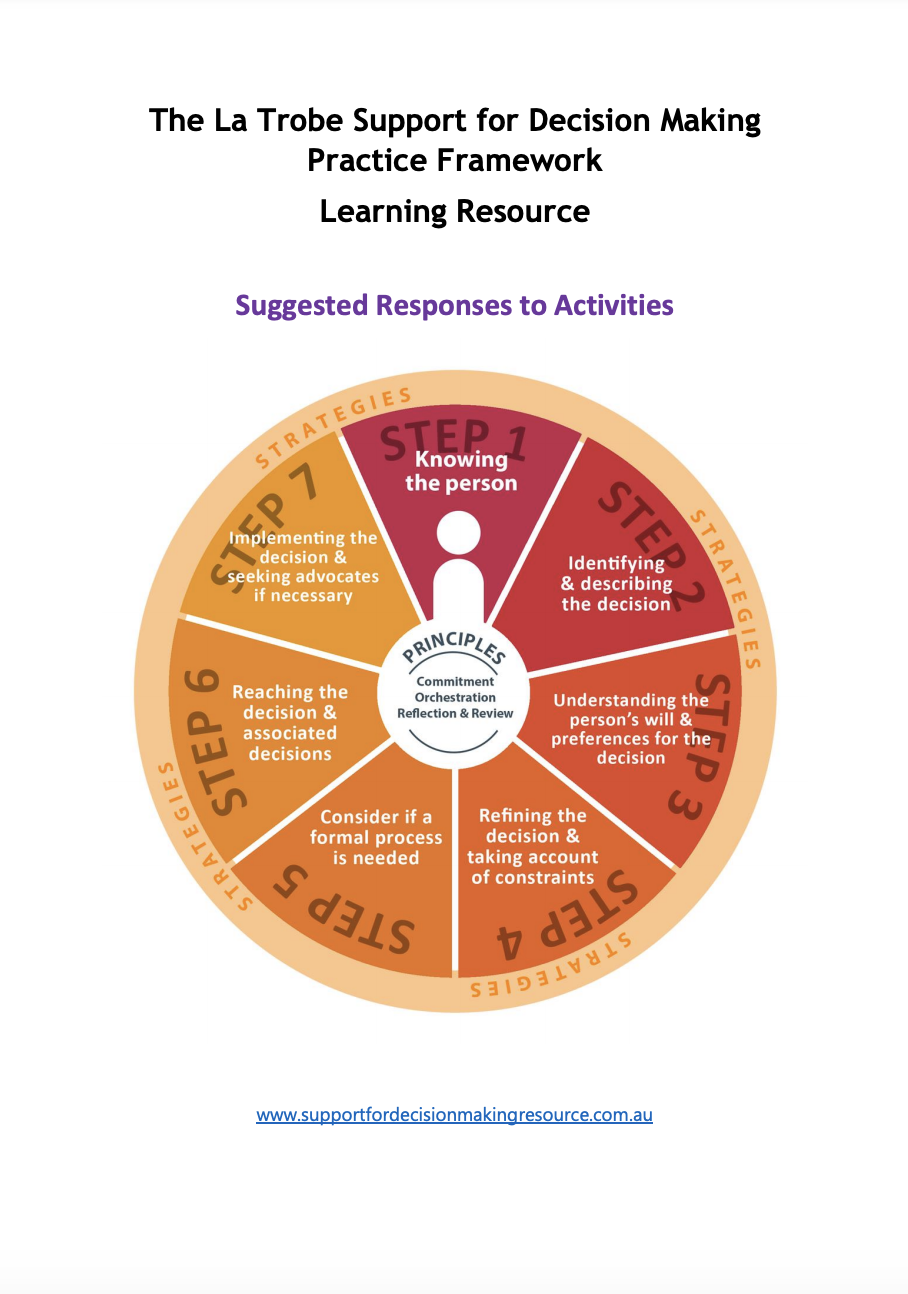
The La Trobe Support for Decision Making Practice Framework Learning Resource
This online learning resource is about support for decision making. It will present the first evidence-based framework to guide you through the process of supporting people with cognitive disabilities to make decisions. Using this framework will help you to enable the people you support to exercise choice and control in their own lives.
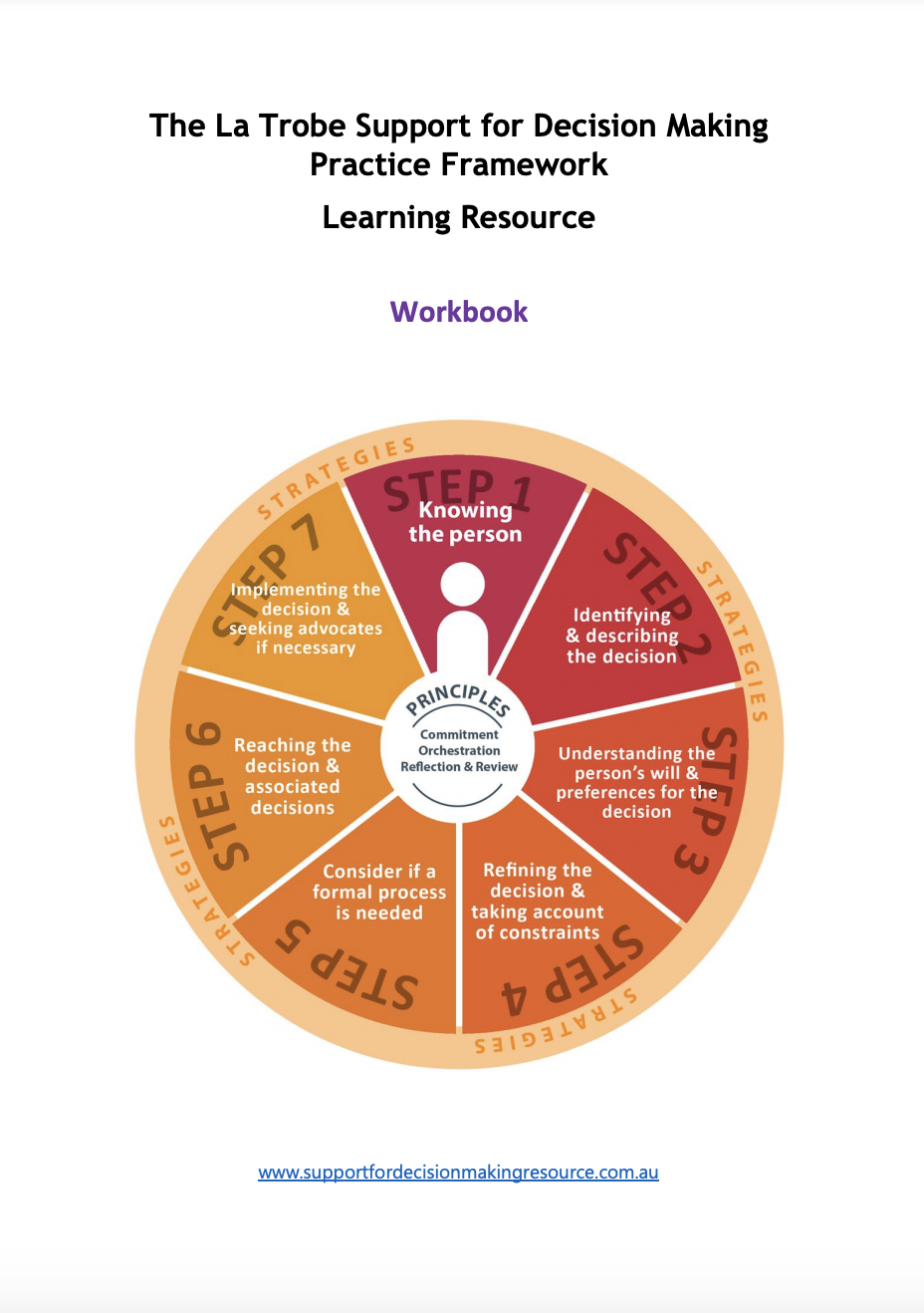
The La Trobe Support for Decision Making Practice Framework Workbook
This online learning resource is about support for decision making. It will present the first evidence-based framework to guide you through the process of supporting people with cognitive disabilities to make decisions. Using this framework will help you to enable the people you support to exercise choice and control in their own lives.
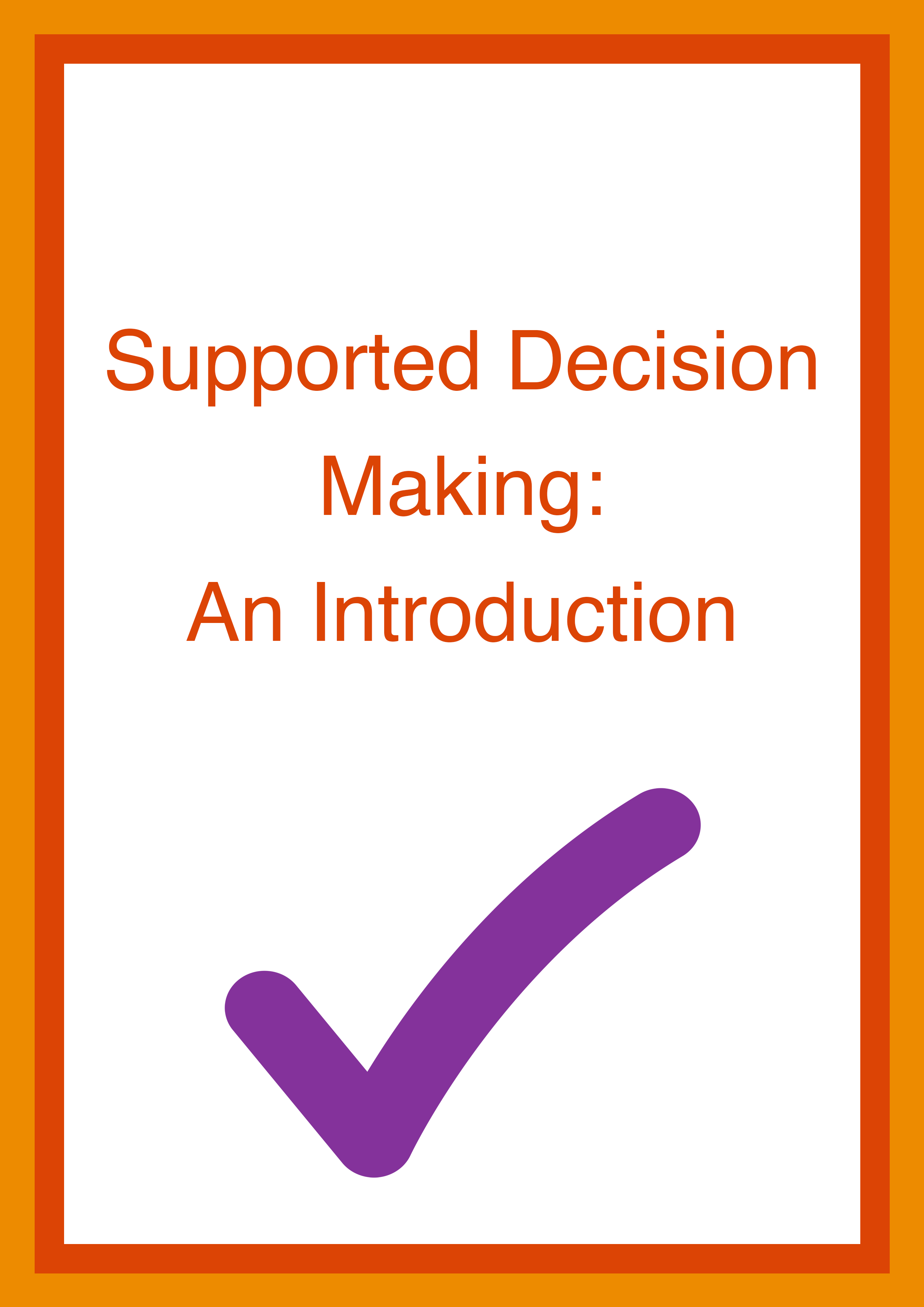
Supported Decision Making: An Introduction
An introduction to Supported Decision Making and how to make your own Supported Decision Making Plan.
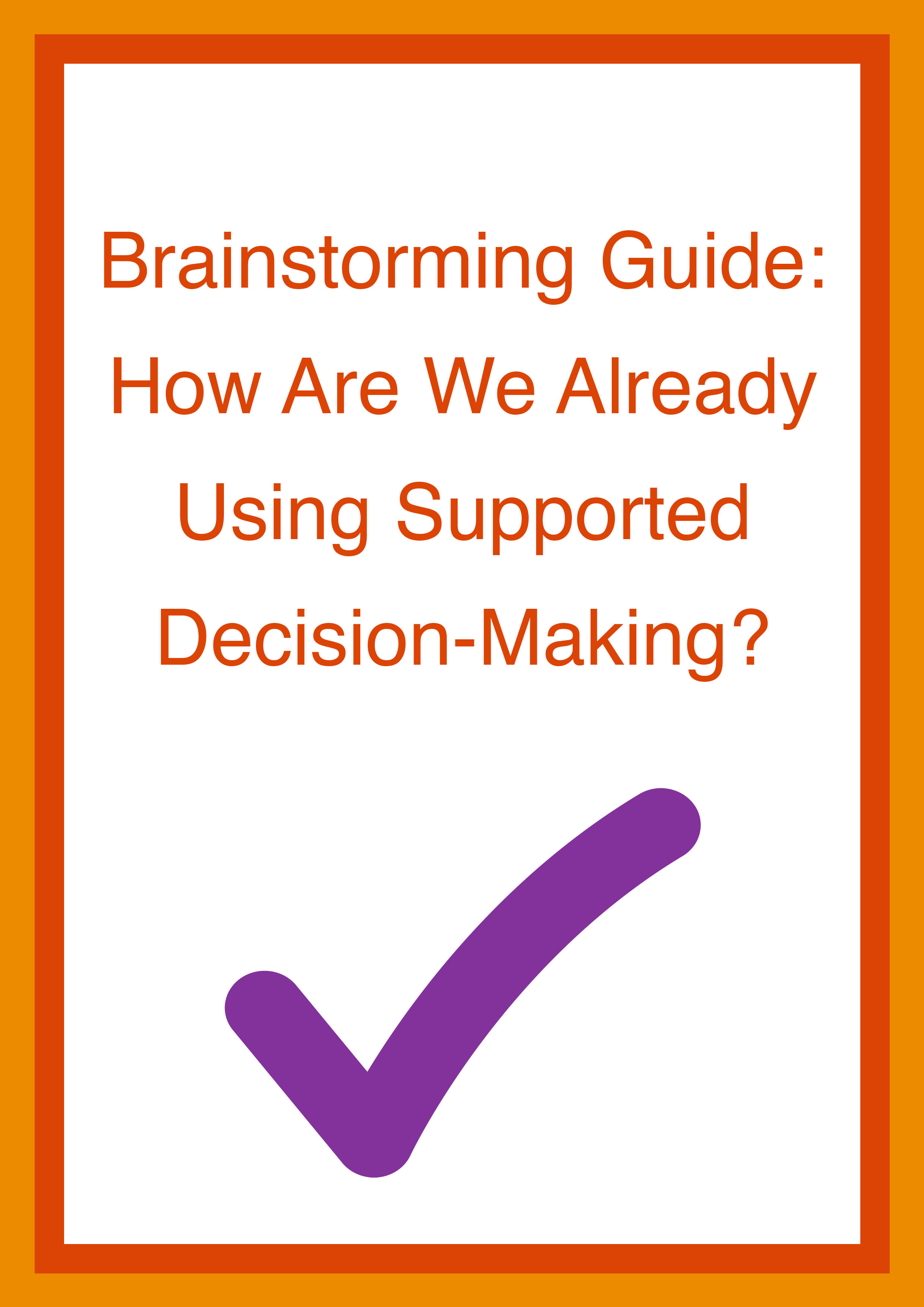
Supported Decision Making Brainstorming Guide
This tool can assist people to brainstorm ways that they are already using supported decision-making, and to think about new ways supported decision-making could support the person with a disability to make their own safe, informed choices.
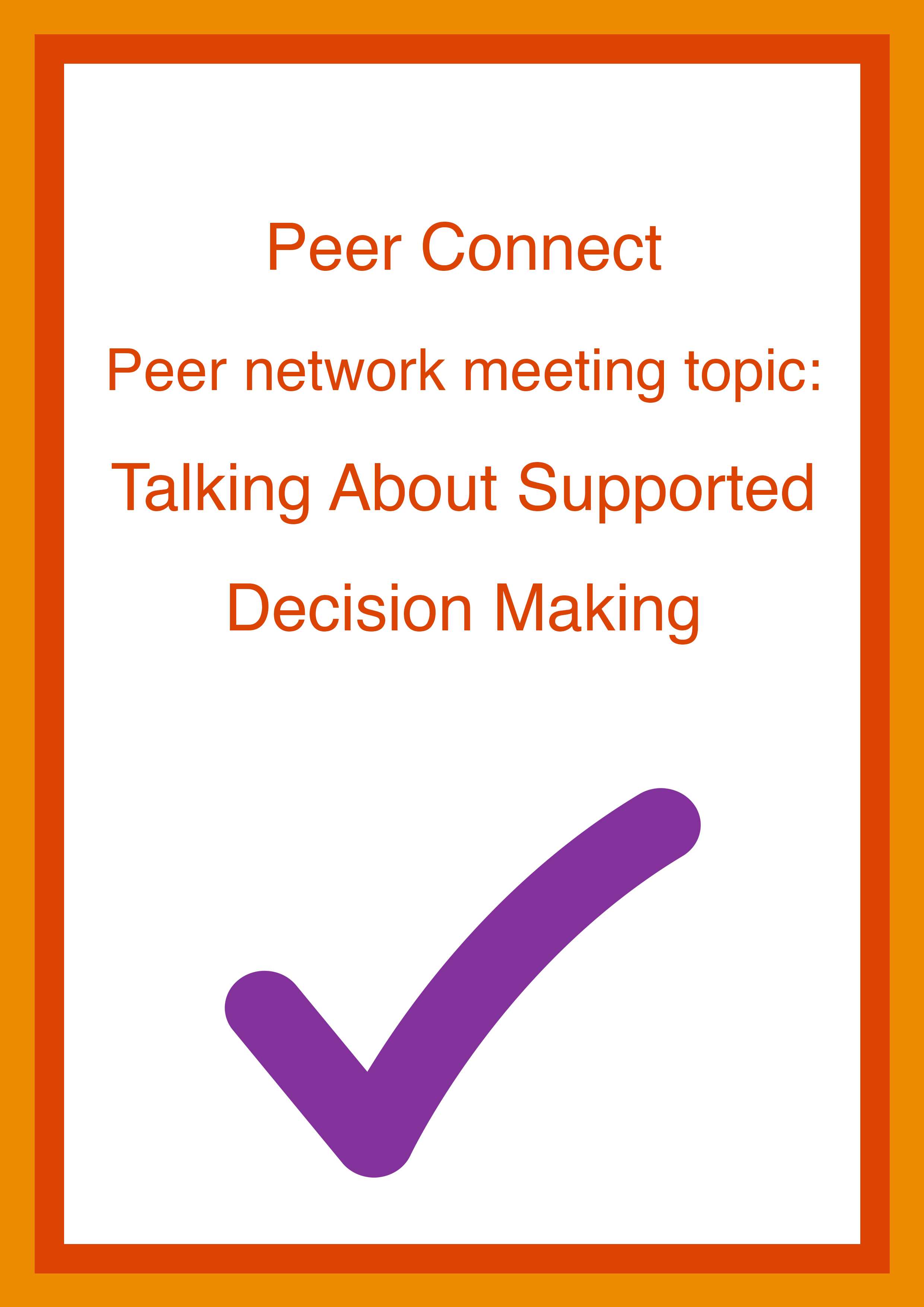
Peer Network Meeting Topic: Talking About Supported Decision Making
Peer networks can help people understand their choices and make decisions for themselves. Sometimes it can be useful to have a conversation about what it means to make a decision. This quick guide looks at how peer networks can talk about this, including supported decision-making.
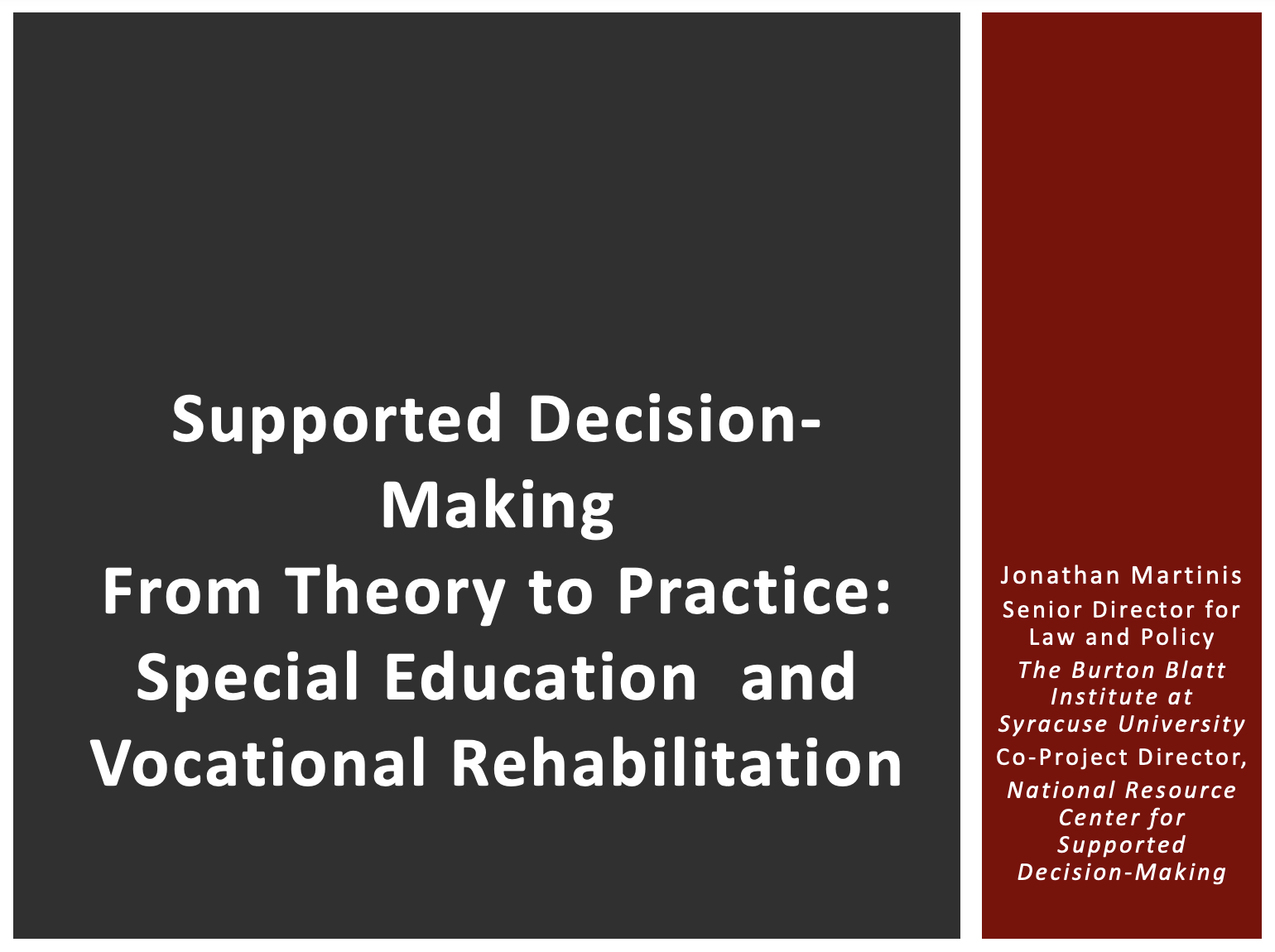
Supported Decision Making From Theory to Practice: Special Education and Vocational Rehabilitation
A presentation from Jonathan Martinis about the importance of starting supported decision making as early as possible for kids in school.
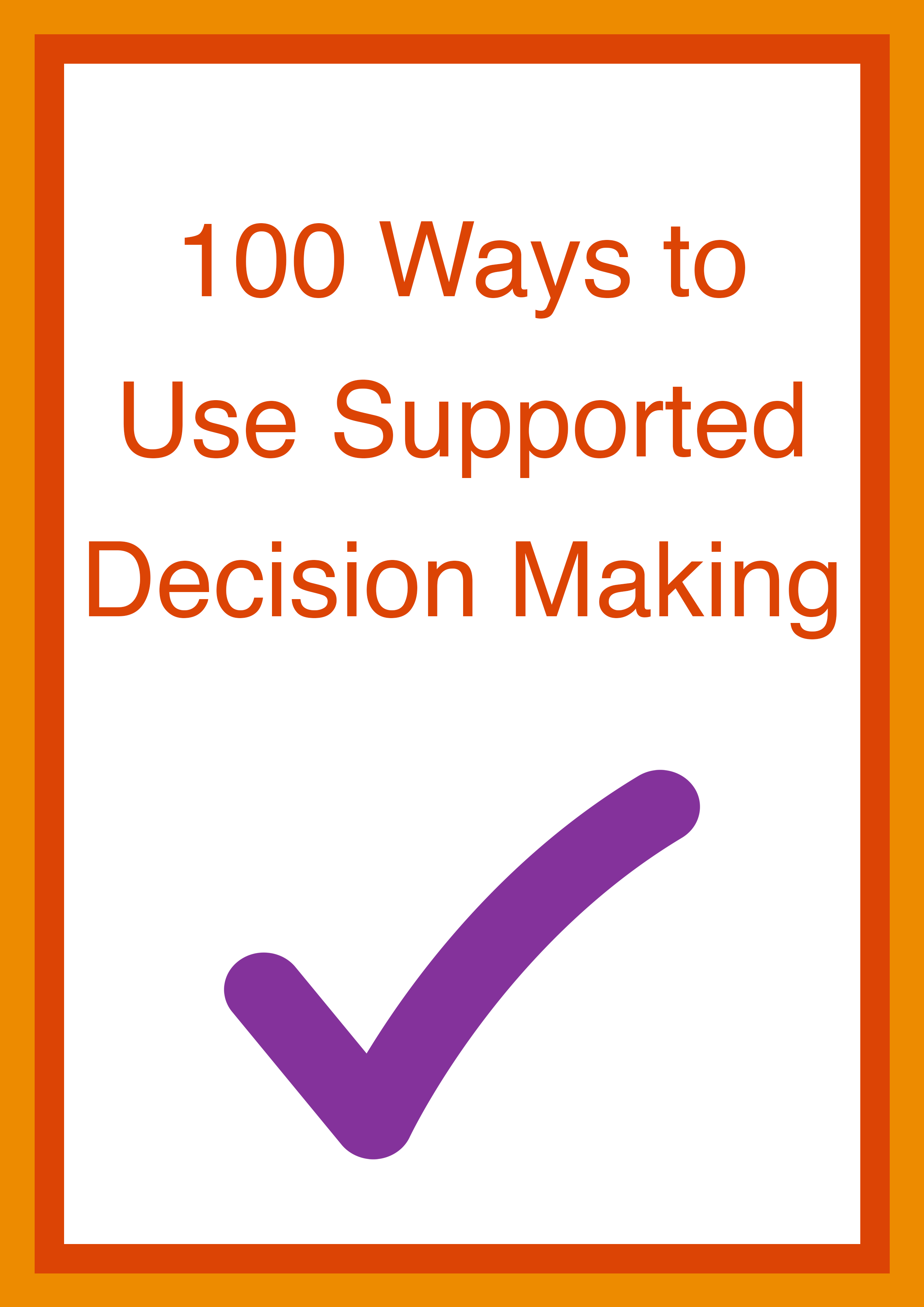
100 Ways to Use Supported Decision Making
A list of different way that Supported Decision Making can be implemented in all areas of a persons life.

It’s My Choice! A Knowledge Review
This is the fifth of five resources in the It’s My Choice toolkit. From a human rights perspective choice plays a central role as one of the primary underlying principles. In the UN Convention on the Rights of Persons with Disabilities (CRPD) choice and autonomy are the basis of the first principle and linked to the aspiration of independence: ‘Respect for inherent dignity, individual autonomy including the freedom to make one’s own choices, and independence of persons…’(Article 3a)

It’s My Choice! Film and Discussion Guide
This is the fourth of five resources in the It’s My Choice toolkit. This Film and Discussion Guide will help you talk about three films about making your own choices.

It’s My Choice! A Guide for Disability Support Providers
This is the third of five resources in the It’s My Choice toolkit. This guide is designed for Disability Service Providers (DSPs) and support workers to support people with disabilities to make their own choices and to develop service and choice planning frameworks that deliver better lives.

It’s My Choice! A Guide for People with a Disability, their Family Carers, Friends and Advocates
This is the second of five resources in the It’s My Choice toolkit: A Guide for People with a Disability, their Family Carers, Friends and Advocates.

It’s My Choice! The Principles of Choice
This is the first of five resources in the It’s My Choice! toolkit. While choice is often spoken about, as a practical task it is far from easy to implement. Developed in partnership by Inclusion Melbourne and RMIT University, this toolkit consists of five guides that support people with a disability, families and support providers to understand and explore the principles of choice. It also provides examples, worksheets and other practical tools to support people to develop their choice making abilities.

The Equal Right to Decide
IRIS is supporting the development of pilot initiatives in communities in Canada and internationally to support people with disabilities to gain choice and control over their lives.

Challenge Newsletter Summer 2021: Communicating and Connecting
This newsletter shares information and examples of good practice from families and professionals. For some children and adults who live with communication challenges the pandemic restrictions have had a major additional impact on already existing communication and connection inequalities.

Emerging Policy and Practice Issues in Supported Decision Making
Michael Kendrick, an international human services consultant with a wealth of knowledge about service delivery issues across the world, discusses emerging policy and practice issues that can impact implementation of supported decision making.

Supported Decision Making Teams: Setting the Wheels in Motion
This paper is a presentation on ways to support your children make their own decisions and direct their own lives, and ways to Set the Wheels in Motion toward lives of independence.

How to Make a Supported Decision Making Agreement
This is a guide for people and families. It contains resources, links and worksheets to start using supported decision making for everyday life.
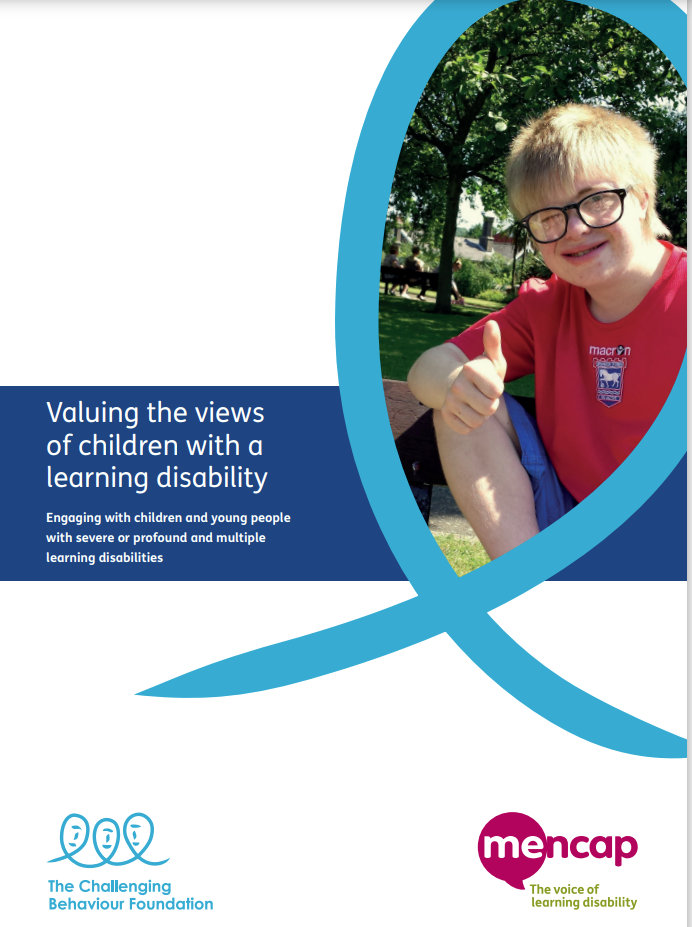
Valuing the views of children with a learning disability
This resource is for anyone involved in supporting children and asks you to stop and think about whether you are doing enough to seek out their views and wishes. It is often assumed that children do not have anything to contribute if they do not have the capacity to understand complex problems. It shows some methods which have been used to actively seek out the views and wishes of children with learning disabilities and signposts practical tools to help you in your efforts.

The Right to Make Choices
This guide helps people understand decision-making laws. You will learn about different kinds of support you can use to make choices. You will also learn about how people in different countries have changed their laws to help people with disabilities make our own choices. Freedom to make our own choices is a human right.

The Right to Make Choices – Easy Read
This Easy Read guide helps people understand decision-making laws. You will learn about different kinds of support you can use to make choices. You will also learn about how people in different countries have changed their laws to help people with disabilities make our own choices. Freedom to make our own choices is a human right.

Looking Differently at Disability and Decision Making
Legal capacity is the right to make decisions that affect your own life. It’s a right that people with intellectual and cognitive disabilities are routinely denied. Michael Bach of the Institute for Research and Development on Inclusion and Society talks about how “supported decision making” can allow those with disabilities to take back control with the help of their families and communities.
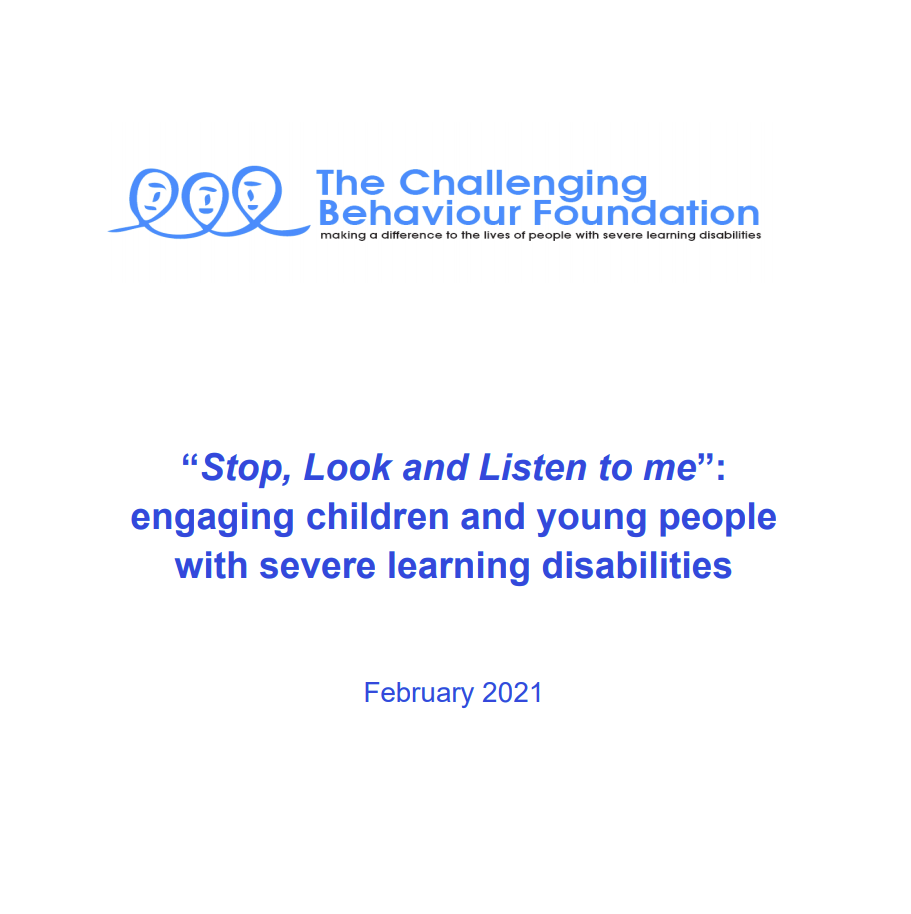
Stop, Look and Listen to Me
Everyone has the right to have their voice heard. However, the Challenging Behaviour Foundation (CBF) hears far too often from families who say their child has been excluded from consultations about services which directly affect their lives, even where there is a legal obligation to listen to their views (for example, section 19 of the Children and Families Act 2014).This project was a small-scale piece of work, combining the expertise of the Tizard Centre and the Challenging Behaviour Foundation to seek the views and wishes of young people. This report contains the results of our “Stop, Look and Listen to Me” project, developed with the Tizard Centre at the University of Kent, to seek the views and experiences of children and young people up to the age of 25.
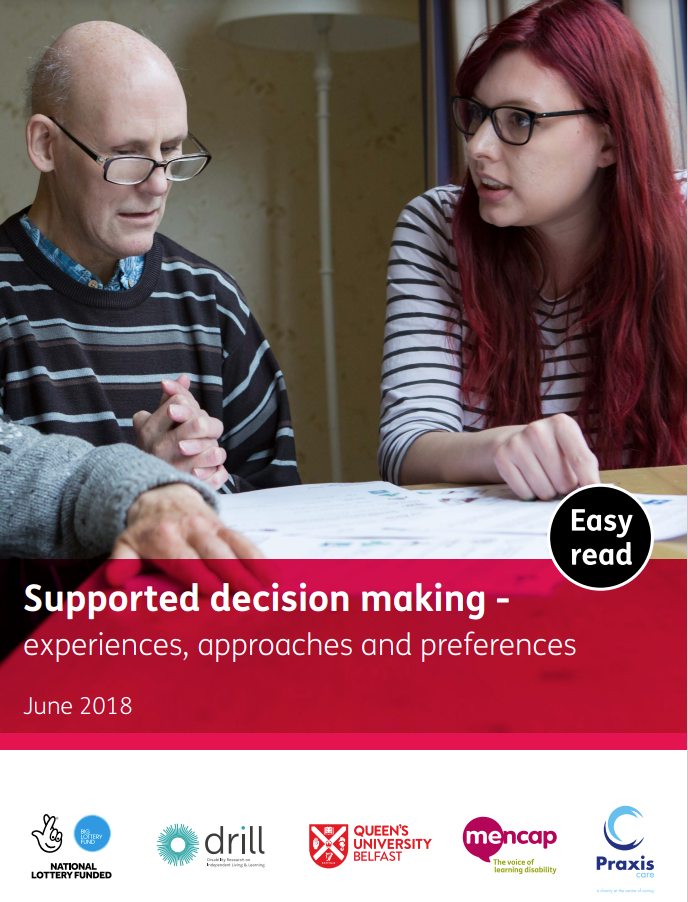
Supported Decision Making: Experiences, Approaches and Preferences-Easy Read
This document is an Easy Read summary of the ‘Supported decision making – experiences, approaches and preferences’ research report. The research report is all about how people have made decisions, and what types of support they like.
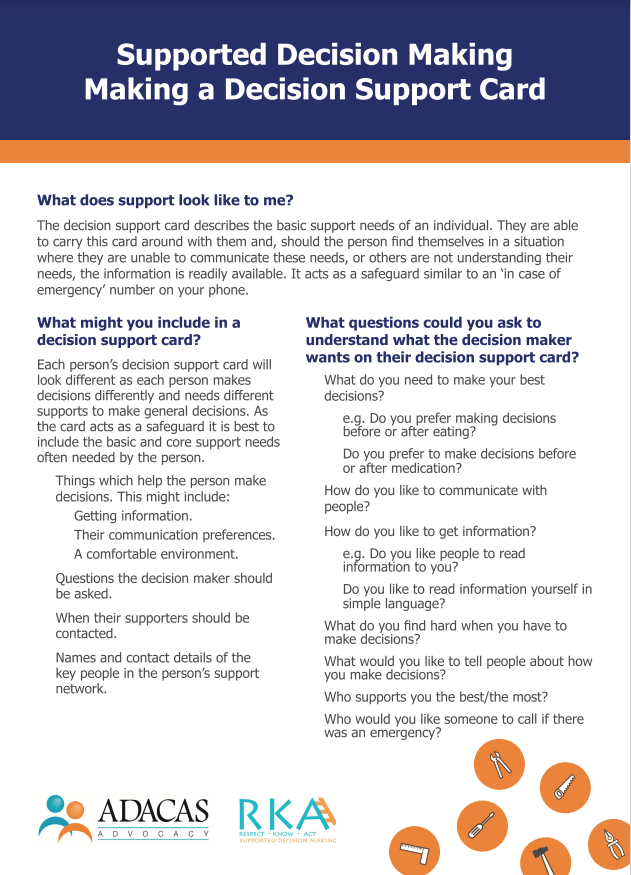
Supported Decision Making: Making a Decision Support Card
The decision support card describes the basic support needs of an individual. They are able to carry this card around with them, should the person find themselves in a situation where they are unable to communicate these needs, or others not understanding their needs ,the information is readily available. It acts as a safeguard similar to an ‘in case of emergency’ on your phone.
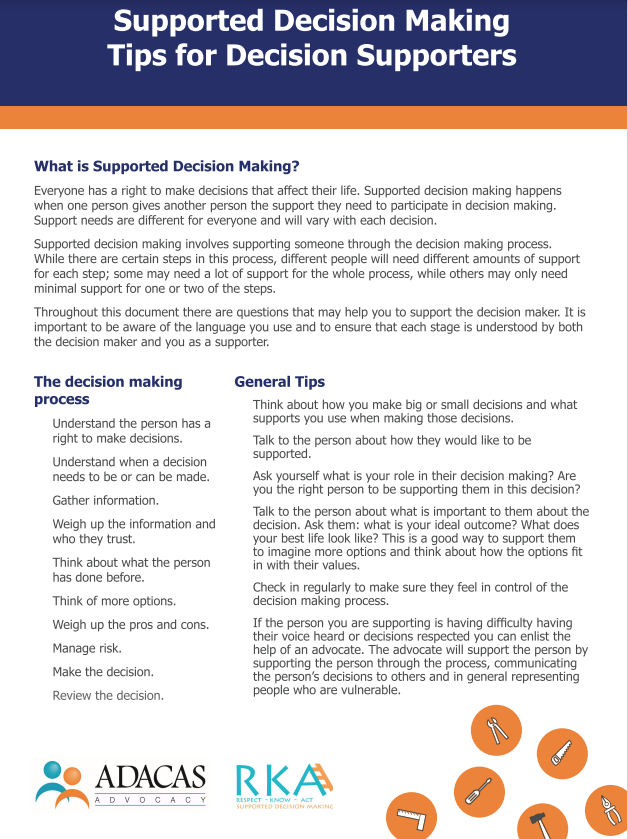
Supported Decision Making: Tips for Decision Supporters
What is Supported Decision Making? This document contains questions that may help decision supporters to support decision makers. It is important to be aware of the language used and to ensure each stage is understood by both the decision makers and the decision supporters.

A Guide to Circles of Support
This workbook from Belonging Matters contains guidance, tips and exercises to explore and establish a circle of support alongside a person. A relationship circle can play an important role in supporting a person’s decision making.
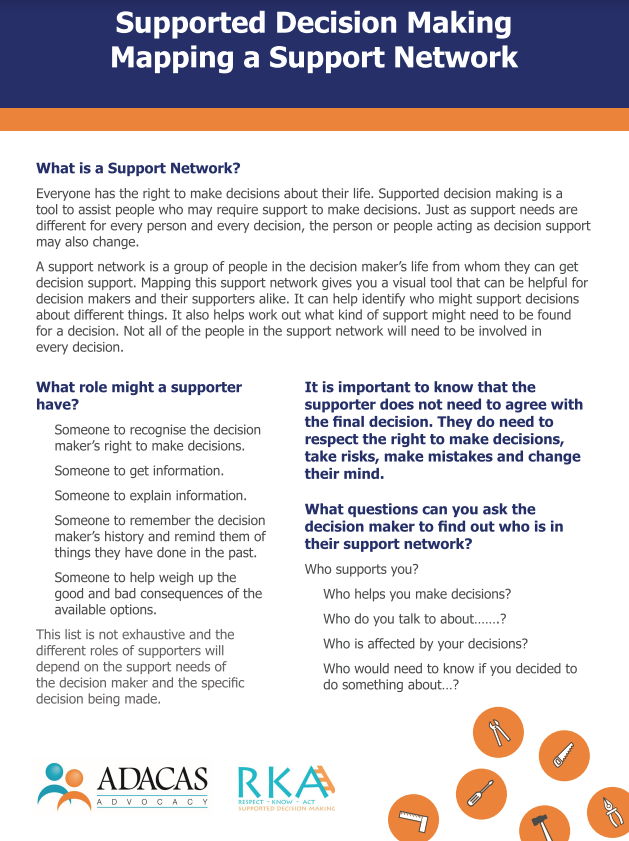
Supported Decision Making: Mapping a Support Network
A support network is a group of people in the decision makers life for whom they can get decision support. Mapping this support network gives you a visual tool that can be helpful for decision maker’s and their supporters alike.
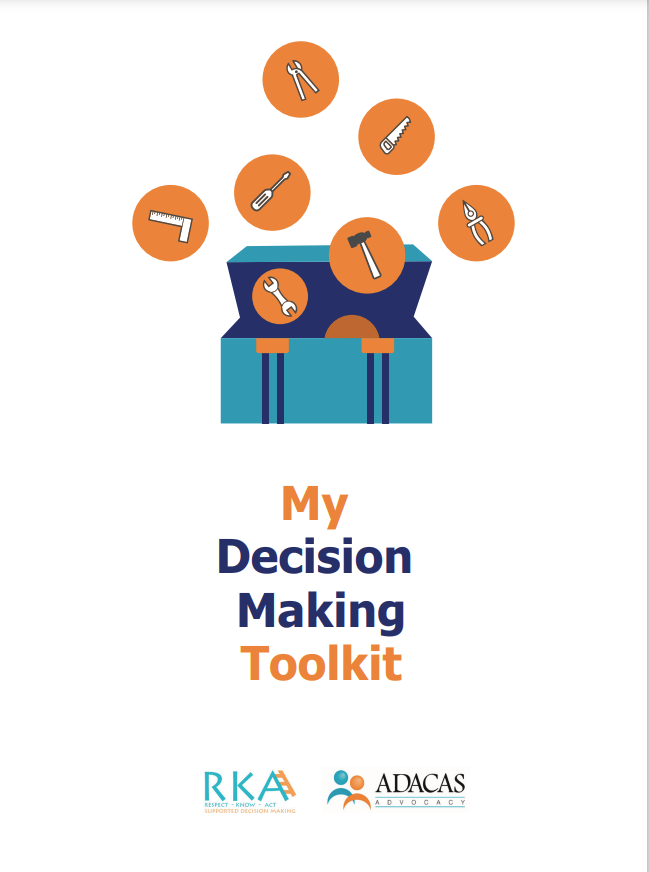
My Decision Making Toolkit
This toolkit is a simple guide for decision making. Everyone has the right to make decisions about their own life. You can use support to make decisions. These decisions should be respected
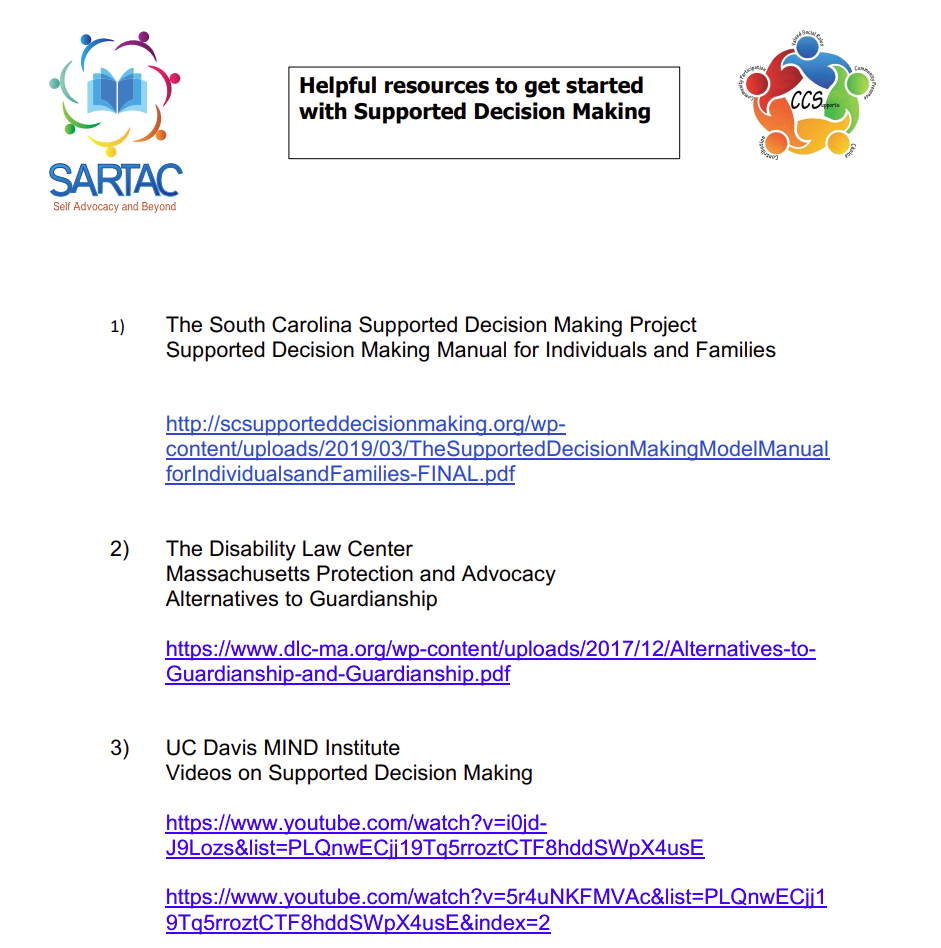
Resources to Get started with Supported Decision Making
The Self Advocacy Resource and Technical Assistance Center (SARTAC) seeks to strengthen the self-advocacy movement by supporting self advocacy organizations to grow in diversity and leadership.

Supported Decision Making – A User’s Guide
This Guide was created by Disability Rights Maine to provide information about Supported Decision-Making to individuals with disabilities and their families and supporters. The goal of this Guide is to illustrate how Supported Decision-Making can be used to support people with disabilities in making their own decisions, and in reducing more restrictive means of support such as guardianship.

Being Me Being You: How I need you to be, to be with me.
This reader has been made to help people and their supporters to talk together about the different ways we can be with each other. It aims to help start a conversation about the different ways people with developmental disability and complex communication needs want others to be around them.

An Introduction to Supported Decision Making
Karly Sciortino – Poulter talks about utilising supported decision making to enable self -determination and as an alternative to guardianship in the US.
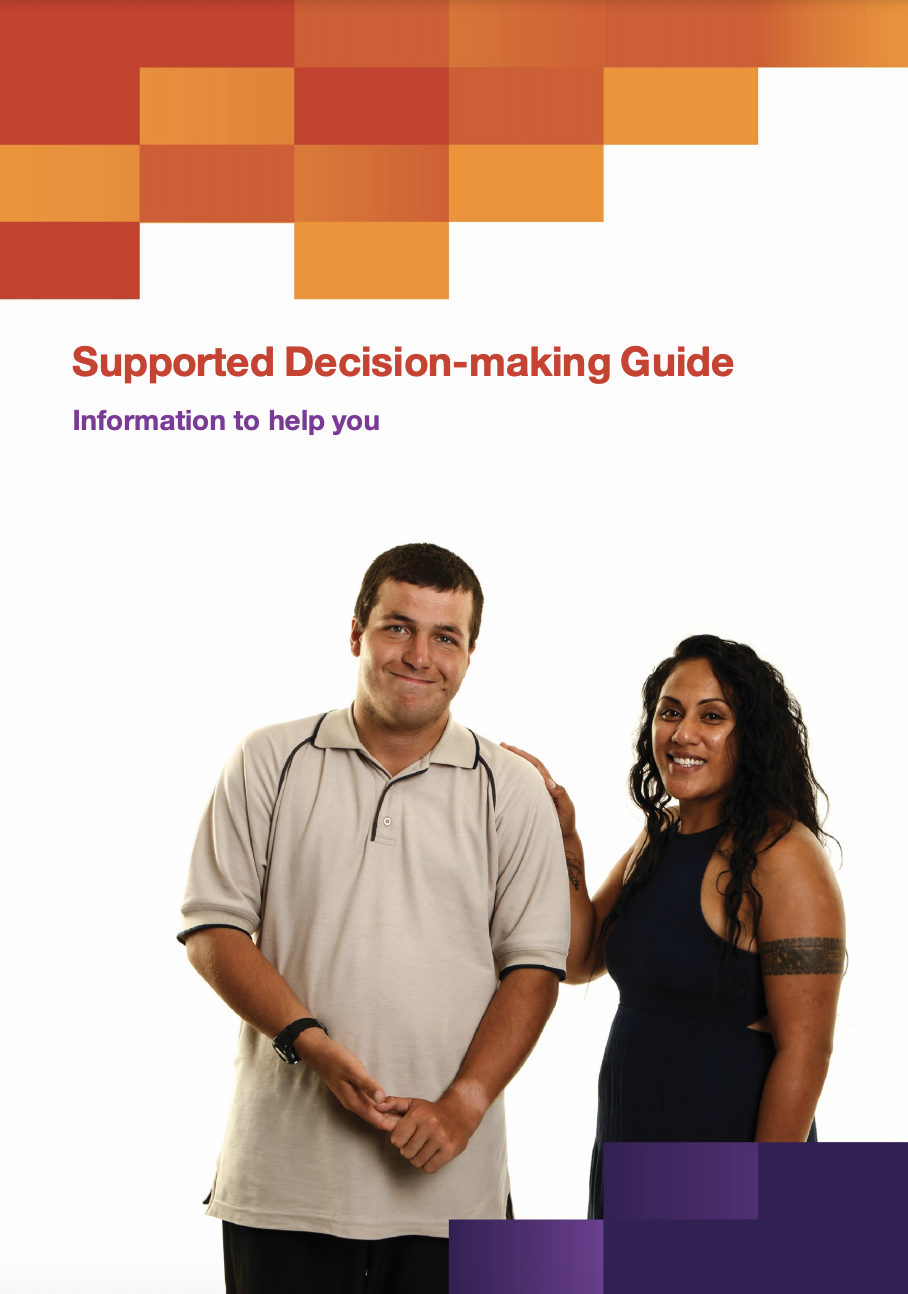
Supported Decision Making Guide
Good person-centred questions can help us learn about people in a way that keeps them in control. The questions can help us build a rich picture of who a person is and how they choose to live their life. We are in a better position to support people in decision-making if we really understand who they are. This is a plain language version of the WAiS Supported Decision Making Guide.
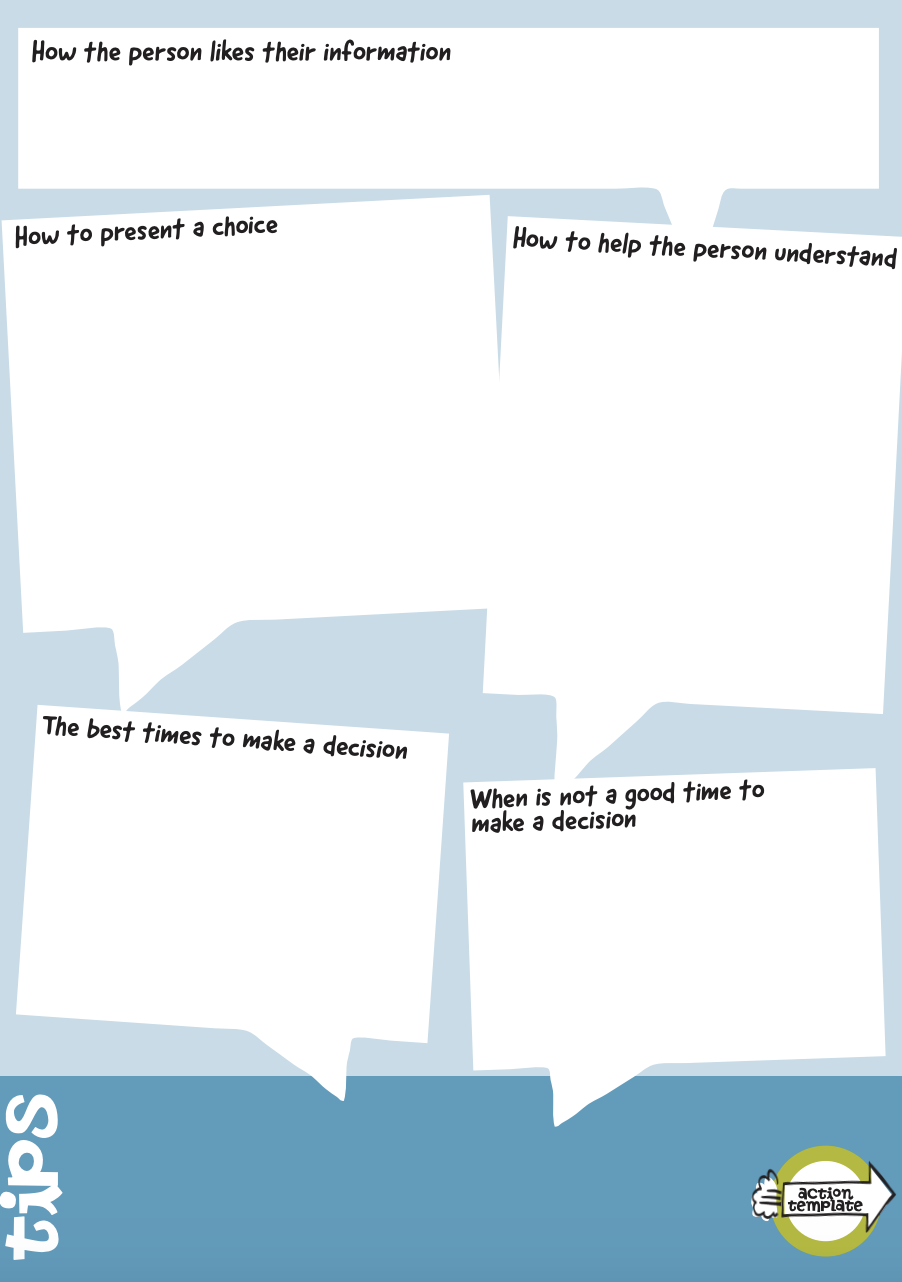
Decision Making Profile
Decision Making Profiles and Decision Making Agreements look at what support someone needs to make decisions in their life, and ensures that they have as much power and control as possible in how these decisions are made. This document explains more about this and has a example template for how you could record this information for someone.
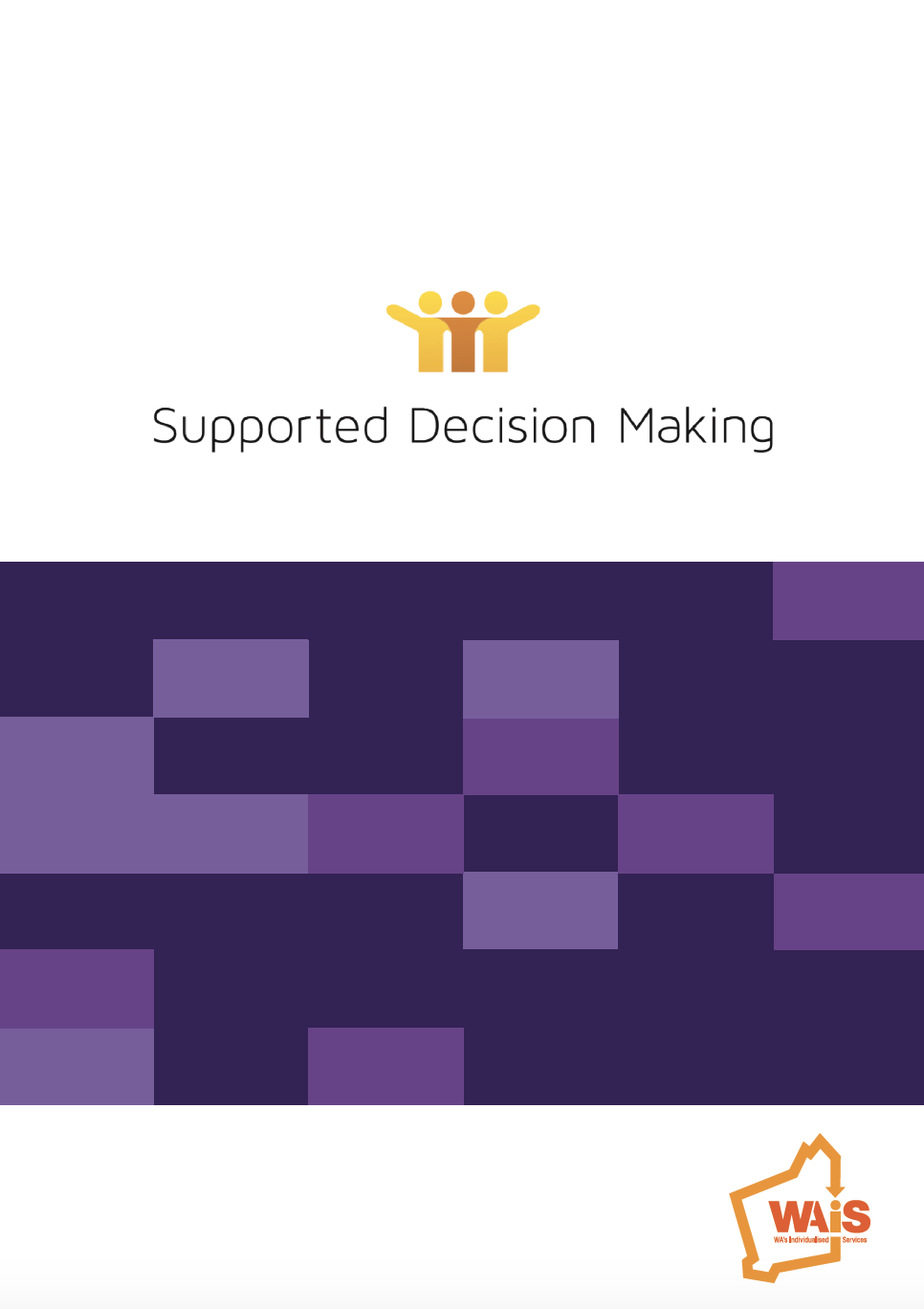
WAiS Supported Decision Making Guide
At WAiS, we work together with people, families and the disability sector to develop a practical approach to supported decision-making, our learning is compiled into this Supported Decision Making Guide.

Supporting Individuals to Live Full Lives
This guide provides important information about empowering individuals to make informed decisions about their life that protect both their rights while ensuring their safety and privacy. Being able to make choices about your life is crucial for the independence and happiness of all people.
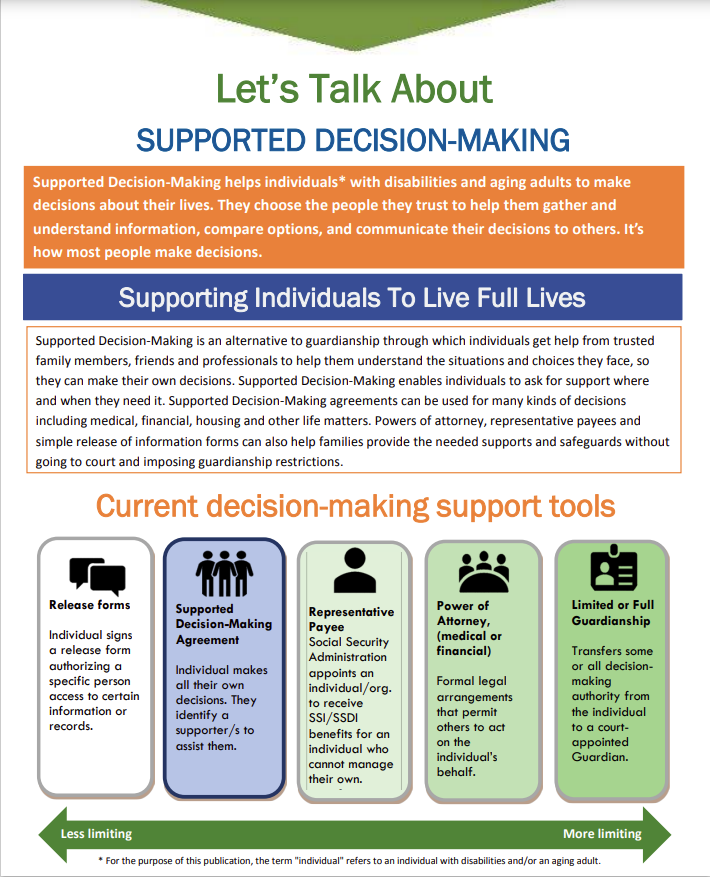
Let’s Talk About Supported Decision Making
This Toolkit provides guidance, tips and templates provided by the Wisconsin Department of Health Services . Wisconsin state law formally recognizes Supported Decision Making agreements as legal arrangements that allow persons to retain their right to make their own decisions, while also choosing trusted people (called Supporters) to help them gather and understand information, compare options, and communicate their decisions to others.

Guidance on Community Mental Health Services
This publication promotes good practice and person-centred, rights based approaches. Many people with mental health conditions and psychosocial disabilities are denied the right to exercise their legal capacity; that is, the right to make decisions for oneself and to have those decisions respected by others.

What Is Supported Decision Making?
Michael Kendrick, an international human services consultant with a wealth of knowledge about service delivery issues across the world, talks about the meaning of supported decision making and the role it can play in, where people are seen as decision makers and could be supported to become good decision makers.

Supported Decision Making: Promoting Individual Rights as an Alternative to Guardianship
South Carolina would benefit from formally recognizing alternatives, like supported decision-making, so those who need support can access it without giving up their rights to control their own life

A Guide to Circles of Support – Easy Read
This guide is to help you start to think about circles of support. This group of supporters can help to support you to make your own decisions about your life.
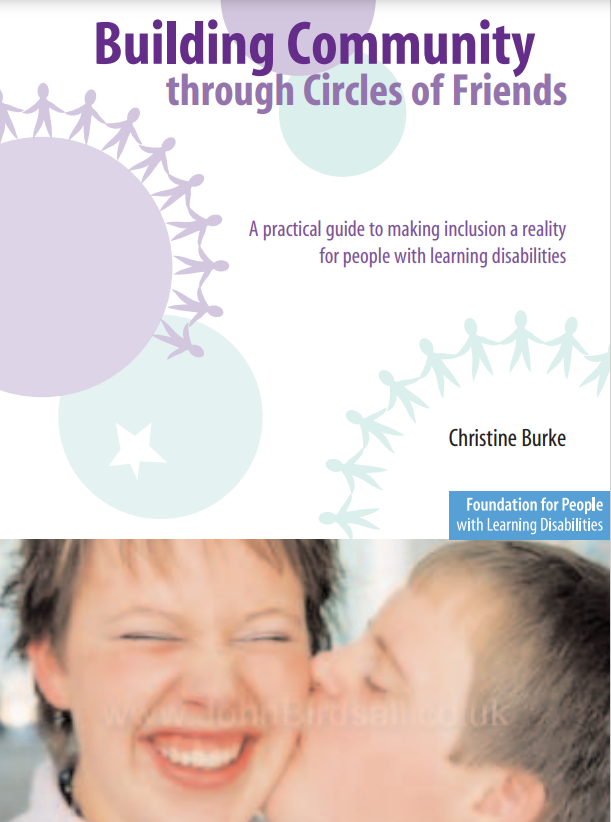
Building Community through Circles of Friends
A practical guide to making inclusion a reality for people with learning disabilities. Through circles of support, people are able to gain more control over their own lives and start to have more natural community relationships.

My Right to Decide
The Council for Intellectual Disability provide training and resources to help build the decision making confidence of people with intellectual disability and their supporters.
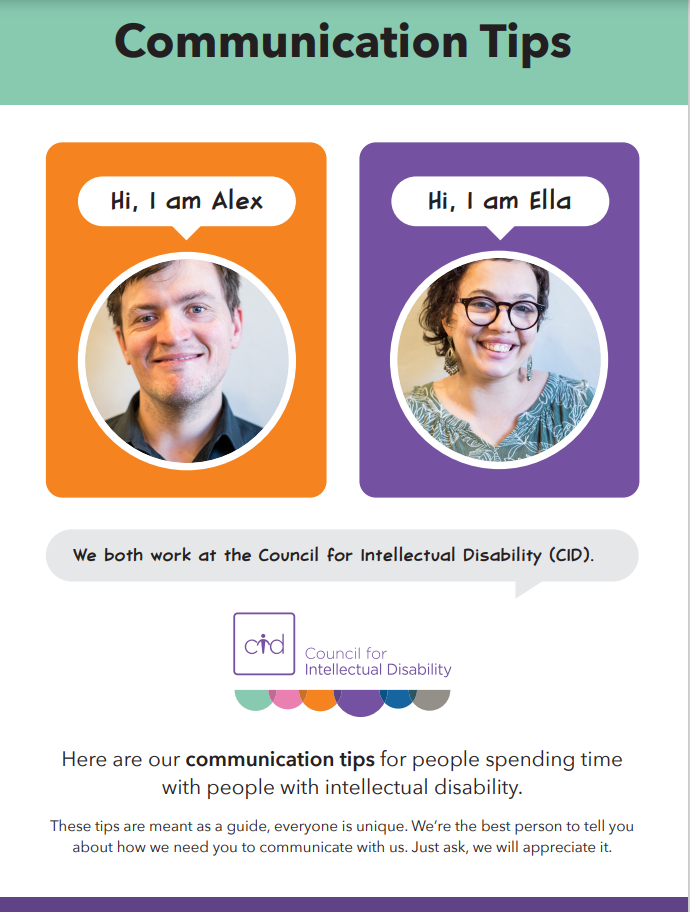
Communication Tips
These tips are meant as a guide, everyone is unique. Communication is key to not only attaining information but also important for us to feel involved, comfortable and heard. Taking the time to ensure communication is accessible means we are included. It means we can understand what is happening.

Supported Decision Making: Let’s Get Started
Everyone has a right to make decisions about their own life. And everyone needs support to make decisions. Supported Decision Making is all about identifying a circle of supporters who will help you.

Supported Decision Making: Individuals
Supported Decision Making is a way to get the advice or help you need making decisions that matter to you in your life. It keeps you in control of your own choices with a little help from people or a person you trust!

Supported Decision Making: Support Person
The principles of Informed Choice, Person Centered Planning and Self-Determination dictate that adults with disabilities are respected and supported in making their own life decisions. Individuals who can make life decisions with support from others around them should be enabled to do so.

Supported Decision Making: Service Providers
Many options, other than guardianship, are available to provide counsel, guidance and assistance with making decisions. Supported Decision Making is an alternative to guardianship that gives individuals with disabilities the support they may need in making their own decisions.

Supported Decision Making: Agreement Worksheet
This worksheet will help you decide the kinds of decisions where you may want a Supporter, who are the people in your life who could serve as Supporters, and how to talk with your Supporter on what you would like help with and what you want to do on your own.

What I Want You to Know: Supported Decision Making Agreement
Supported Decision Making agreements allow individuals to retain their civil rights to make their own decisions while allowing friends, family and trusted allies (Supporters) to support them as they make their own decisions.

Practical Tool and Resource Guide for Lawyers: Steps in Supporting Decision Making
The comprehensive resource guide for lawyers includes a four page fillable PDF tool, which aims to help lawyers identify and implement decision-making options for persons with disabilities that are less restrictive than guardianship. This resource is a joint product of four American Bar Association entities – the Commission on Law and Aging, Commission on Disability Rights, Section on Civil Rights and Social Justice, and Section on Real Property, Trust and Estate Law, with assistance from the National Resource Centre for Supported Decision-Making.

Position Statement: Autonomy, Decision Making Supports and Guardianship
Position statement of The Arc and the American Association on Intellectual and Developmental Disabilities on autonomy, decision-making supports, and guardianship.

Supported Decision-Making video resources
These videos explain supported decision-making. They were launched in November 2022 by the Living My Life Project to provide organisations, services, and professionals access to resources that will help them build the decision-making capacity of the people who use their services.

Supporter’s Guide: How to Support Everyday Decision Making
This supported decision-making guide is written for people who provide assistance to others when making decisions in everyday life. It aims to provide a framework for understanding the process of supported decision making, a summary of it’s aims and principles and greater clarity regarding the role and responsibilities of decision supporters.

Using Supported Decision-Making: A Step by Step Guide
This video is a step-by-step guide to brainstorming about supported decision-making and implementing a supported decision-making agreement. We will walk you through a worksheet that helps people think about what areas of their lives they need support in. We will then take you through the steps of filling out a supported decision-making agreement, and show you examples of how some people with disabilities use supported decision-making in their lives.
What is Supported Decision Making?
Dr Browning explains the practicalities of Supported Decision Making.
Funded by the Australian Government Department of Social Services. Go to www.dss.gov.au for more information.

No More Waiting
This planning guide is intended to provide organisations with information to assist them to be ready to engage with Aboriginal and Torres Strait Islander people with disability and their families in planning for social care. Aboriginal people with disability and their family members may also find this guide helpful to use in conjunction with individual planning resources, some of which are mentioned in section four of this guide.
What Is Supported Decision Making?
This animation describes the process of practical assistance with decision making to people who need support.
Funded by the Australian Government Department of Social Services. Go to www.dss.gov.au for more information
Paul Jay – AGOSCI Conference 2022
Paul has had quality support for his decision making for many years. He’s been involved in two WAiS supported decision making projects, most recently as a member of the Advisory Group for ‘Decision Making Possibilities’. In September 2022 he shared this prepared presentation about why supported decision making is important at the AGOSCI conference in Hobart.

Literature and practice review: Support to make decisions that promote personal safety and prevent harm
The NSW Council of Social Service (NCOSS) is undertaking an action research project to develop (1) a practice model of delivering supported decision-making with a safeguarding focus for people with disability and (2) organisational capacity to provide best practice individual safeguarding support to a diverse range of people with disability. The Social Policy Research Centre (SPRC) has been commissioned to provide research advice, training and action research practice support to NCOSS.

Skilled to Thrive Project Plan: Support to make decisions that promote personal safety and prevent harm
This project research plan was undertaken in 2017. Changes in disability policy, such as the introduction of the National Disability Insurance Scheme (NDIS), entail a move away from substitute decision making for the person with disability to supported decision making by the person themselves, with appropriate safeguard supports to reduce the risk of harm. The project objective is for NSW Council of Social Service (NCOSS) to develop a practice guide to inform organisational capacity to support workers who support people with disability to make decisions about personal safety ,wellbeing and preventing harm.
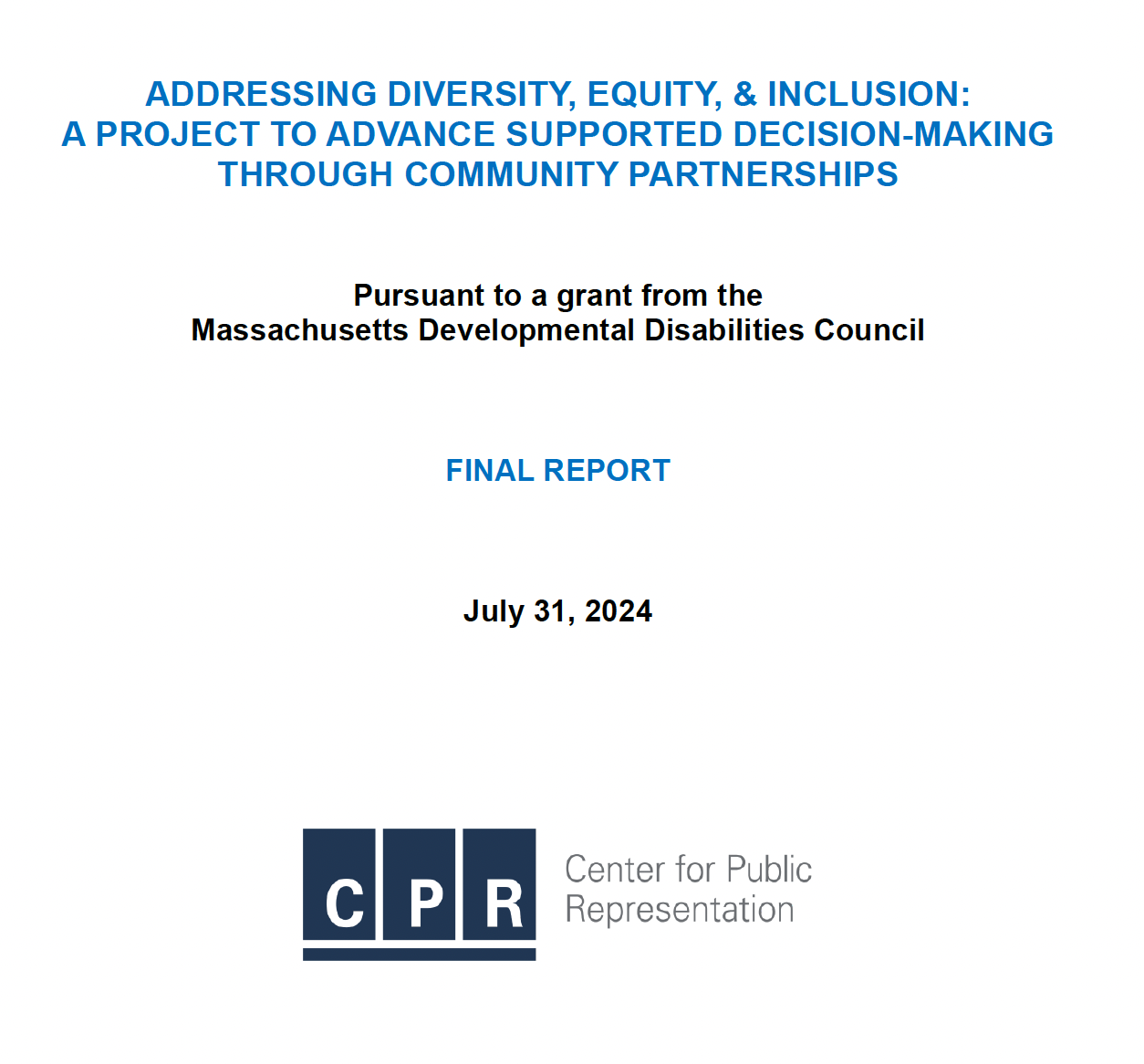
SDM through Community Partnerships
As part of the Racial Equity and Supported Decision-Making Initiatives, Center for Public Representation worked alongside community partners to pilot trainings on SDM and other alternatives to guardianship for family members and people with intellectual and developmental disabilities within underrepresented and underserved populations in Massachusetts.

The Tree of Life: Practice Guide
The Tree of Life tool presented here is adapted from the work of Ncazelo Ncube-Mlilo (REPSSI) and David Denborough at the Dulwich Centre Foundation. Their work is based on narrative therapy and collective narrative therapy for people who have experienced traumatic events. This practice guide is for disability advocates, social services staff and group facilitators who assist people through tough times and prepares workers to help people make decisions in difficult periods of their lives.

Foundational Patterns for Peer to Peer Responses
This toolkit documents the guiding foundations to consider when developing and scaffolding your own peer to peer responses.

Common Threads – Approaches & Contexts for Planning Everyday Lives
The Common Threads Conference was a gathering of people engaged in small group conversations and story telling to share and reflect on their understanding and experiences of person centred practice. This reflection by John O’Brien features profiles of ten approaches to person centred planning.

Supported Decision Making in Victoria
This guide takes readers through the various ways in which supported decision-making can occur in Victoria, taking account of all the legal possibilities, while also providing best-practice advice. Supported decision-making is different to other decision-making practices such as traditional guardianship, where a person with a disability is represented by another in their decision-making.

People with Disability and Supported Decision-Making and the NDIS
This introduction provides information about why supported decision-making is important, how to use this guide, and an overview of the 4 sections. This document is primarily a national resource, which uses some examples from NSW to evidence one approach, which providers in other states will need to confirm with their own state government or responsible body.

S.T.O.G Worksheet
This worksheet can be used if you wish to list your possibilities and solutions for “A good way to make decisions S.T.O.G – Stop , Think, OK?, Go!” Resource adapted by Western Australia’s Individualised Services from “A Guide to Training in Decision-Making for People with Developmental Disabilities” Horrigan Cole Enterprises.

S.T.O.G. A Good Way to Make Decisions
This is a practical guide to “A good way to make decisions S.T.O.G – Stop , Think, OK?, Go!” Resource adapted by Western Australia’s Individualised Services from “A Guide to Training in Decision-Making for People with Developmental Disabilities” Horrigan Cole Enterprises.

Supported Decision Making: A Copernican Revolution
While supported decision-making is about helping others to make decisions, its vision in many respects is revolutionary, and asks us to think about some fundamental things differently. By recognising decision making as an interdependent process and embracing a new way of thinking about decision-making capacity we are able to forge new ways for people with disability to take back control of their lives. Many people with disability have been subject to informal and formal substituted decision-making arrangements directed by what other people believe to be in their best interest. Article 12 of the United Nations Convention for the Rights of Persons with Disabilities (UNCRPD) says this is no longer acceptable. All people have a right to receive the support they need to direct the decisions which shape their lives and be legal decision makers.

Supported Decision-Making – Experiences of a Decision Supporter
This is part five of a five part series on supported decision-making. Hear from Carolyn about her experiences being a decision supporter and advocate.

Supported Decision-Making – The experiences of a decision maker
This is part four of a five part series on supported decision-making. Hear from Ruby about ways she has been supported to make her own decisions.

Supported Decision-Making – Supporting good decision making processes
This is part three of a five part series on supported decision-making. Good support for decision-making starts with helping the decision maker identify there is a decision to be made. People need to understand what the decision is about, and be made aware of constraints affecting the process such as limited time.

Supported Decision-Making – Supporting guardianship to become the last resort
This is part two of a five part series on supported decision-making. Currently, the Public Advocate is appointed by the South Australian Civil and Administrative Tribunal when a person who needs to make an important decision for themselves is found to have a mental incapacity. However, good decision support can change a person’s capacity in relation to their decision-making.

Decision Support as a Fundamental Human Right
This is part one of a five part series on supported decision-making. Over the course of our lives, we will all need support to make important decisions. When we experience disability through illness, injury, stress, trauma and the influence of major medications we may need significant support to be able to make decisions.
Aims of Supported Decision Making
Dr Browning speaks about the two important aims of Supported Decision Making.
Dr Browning refers to a video on legal capacity by Michael Bach which you can watch via this link: Looking Differently at Disability and Decision Making – YouTube
